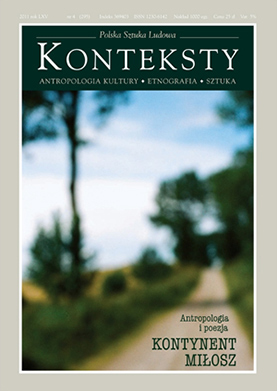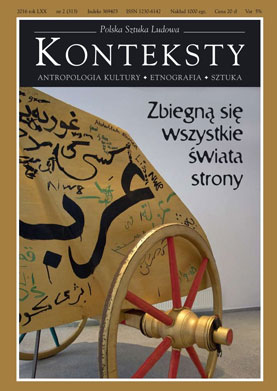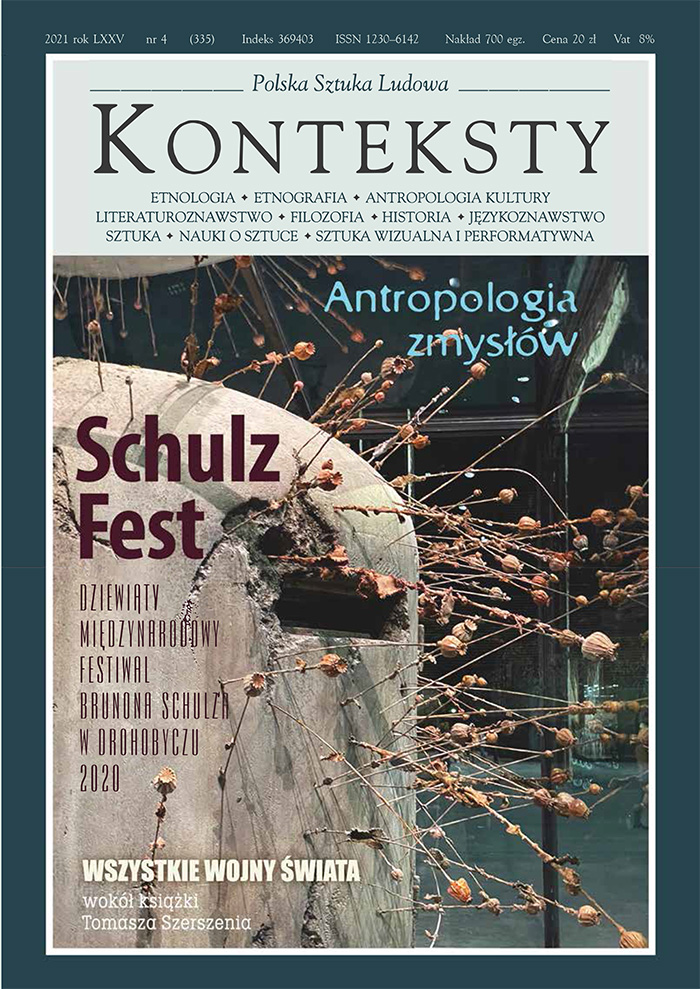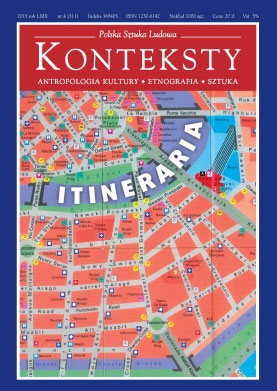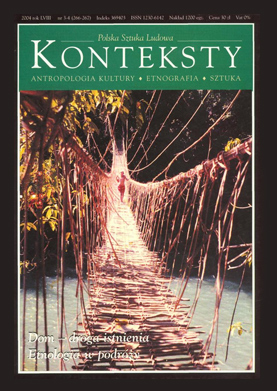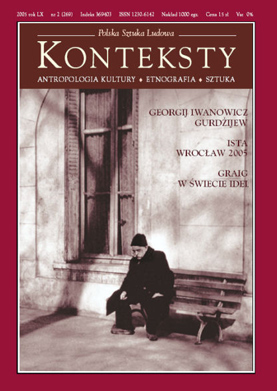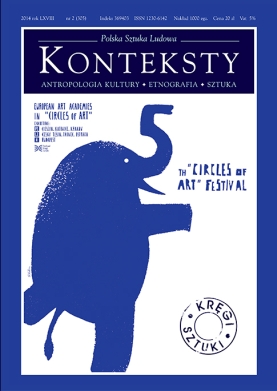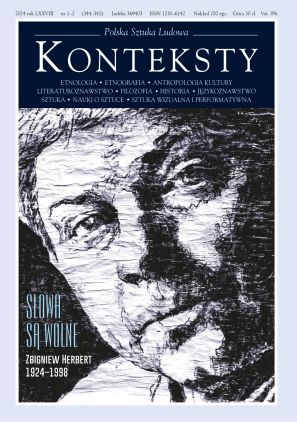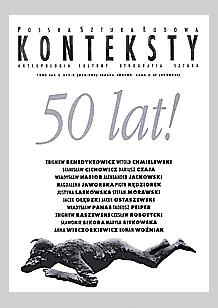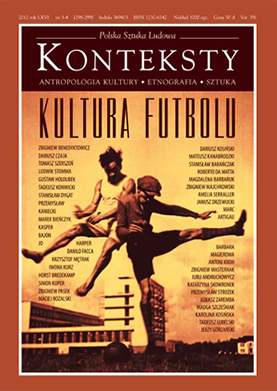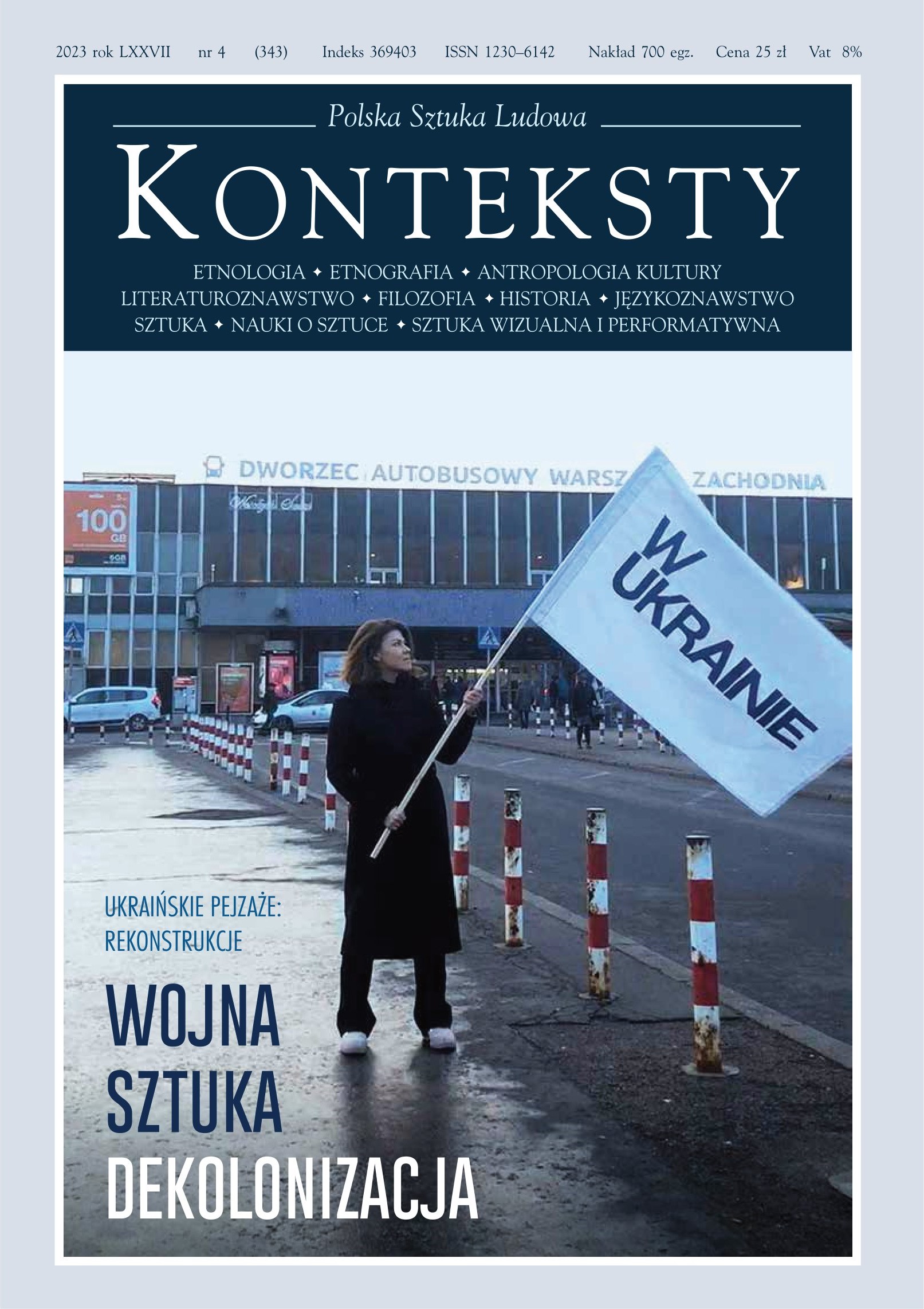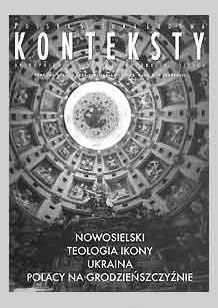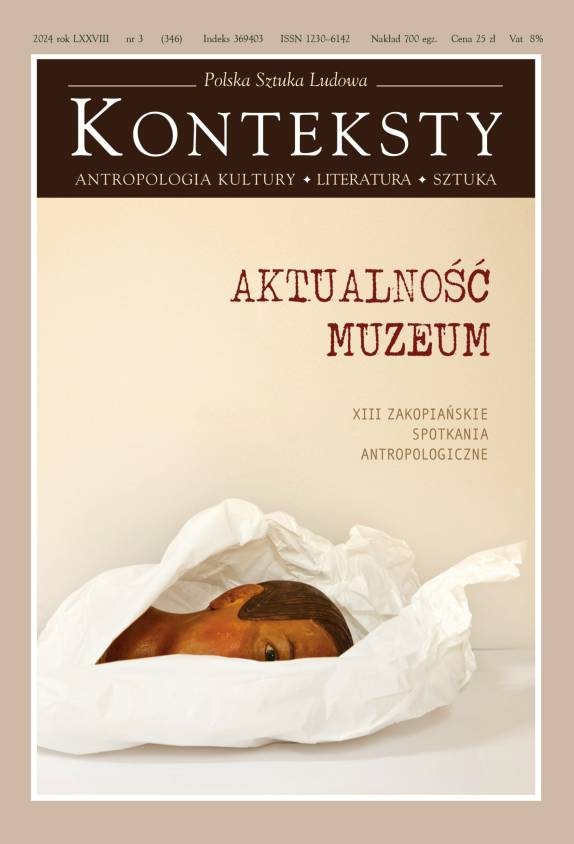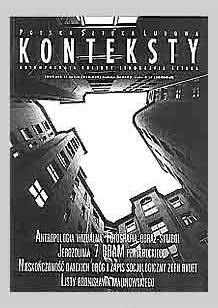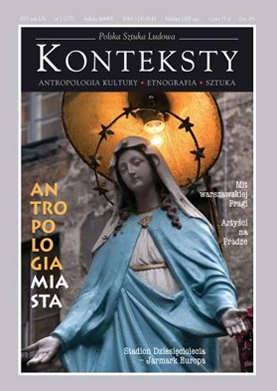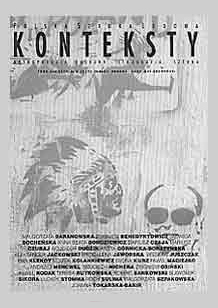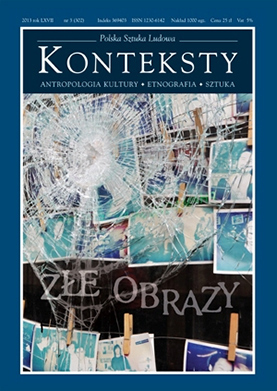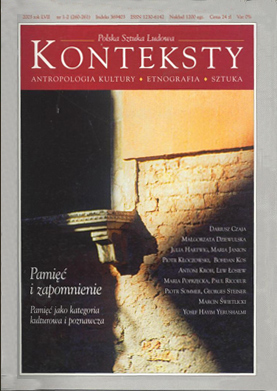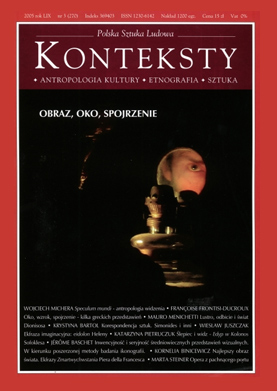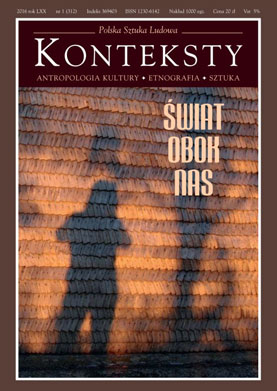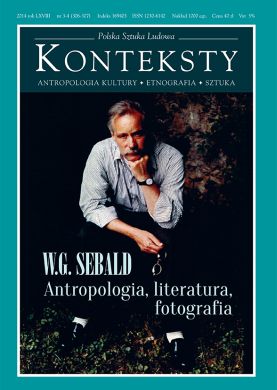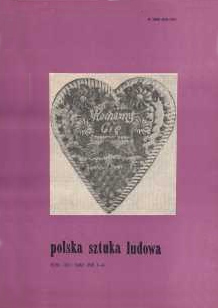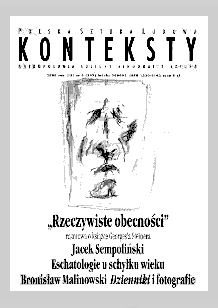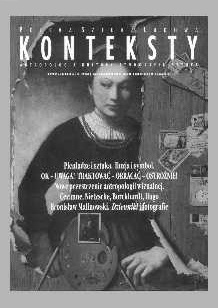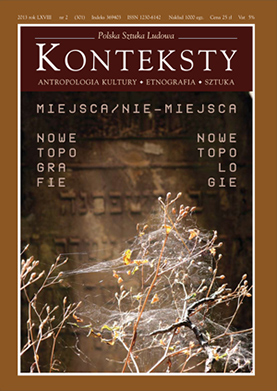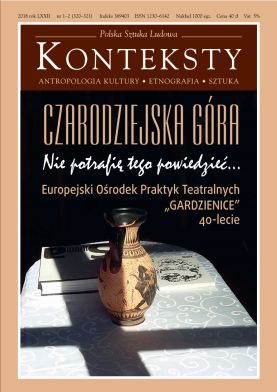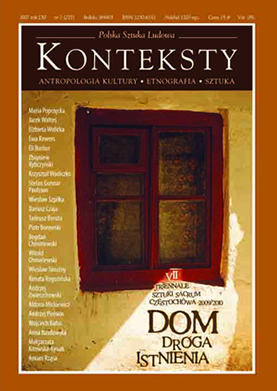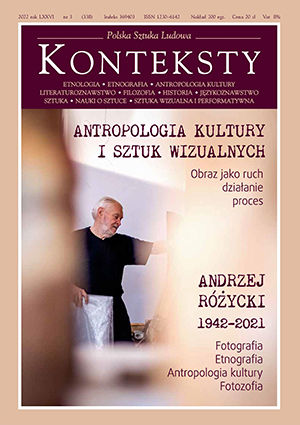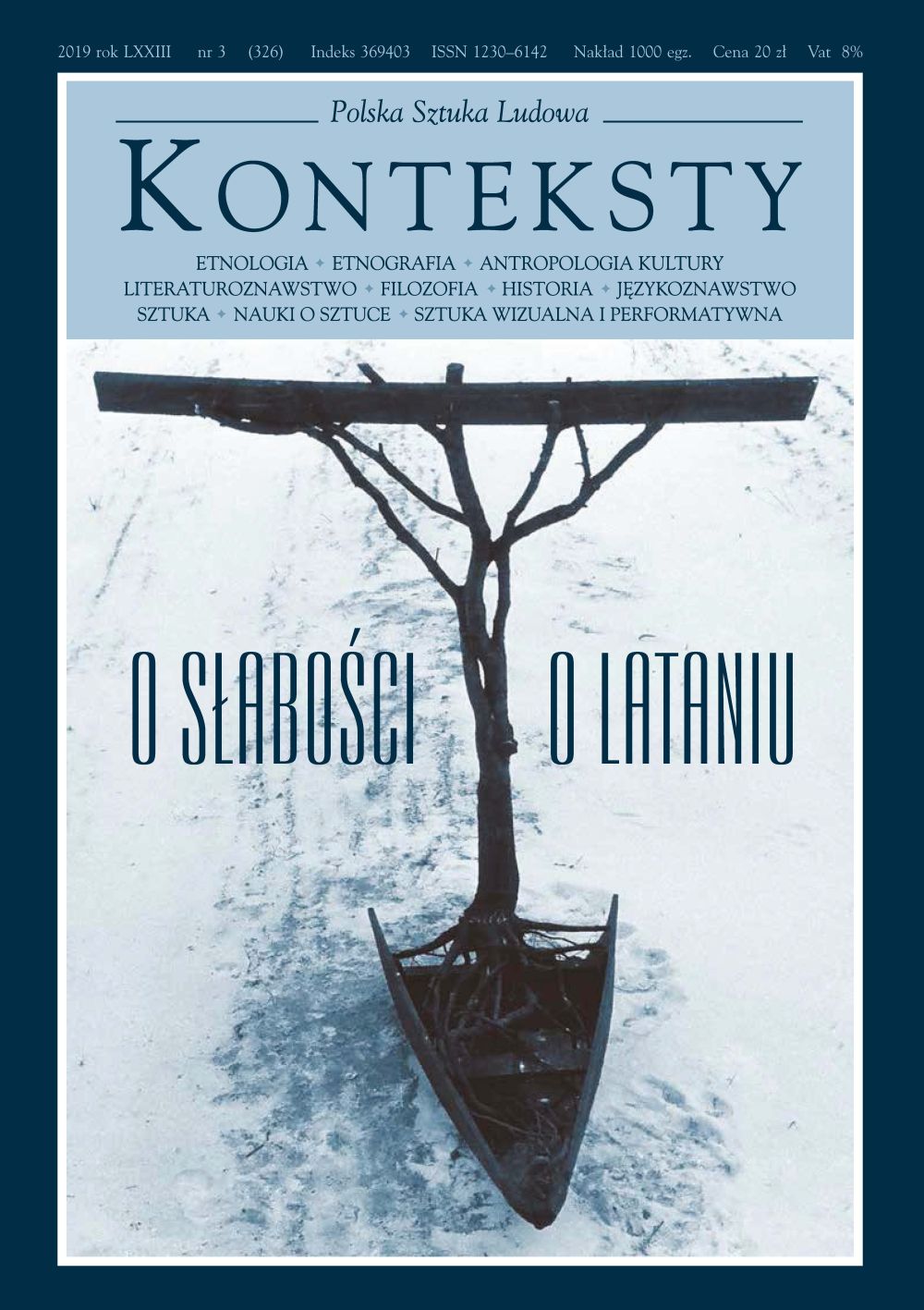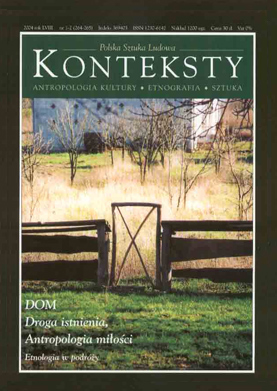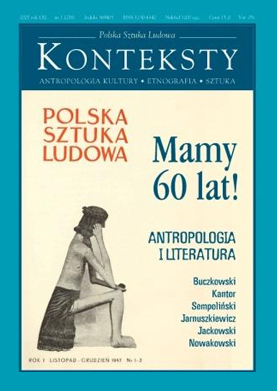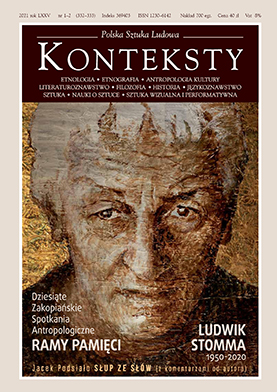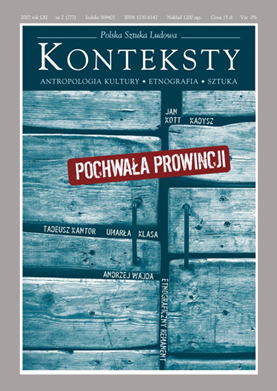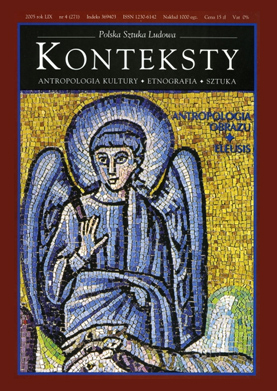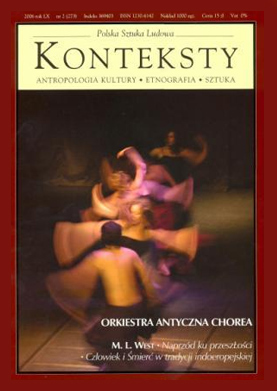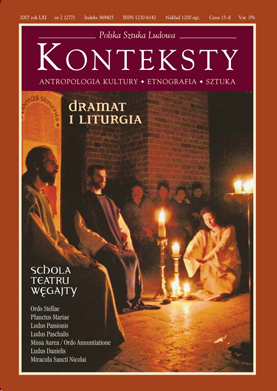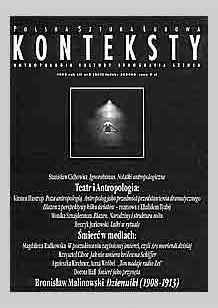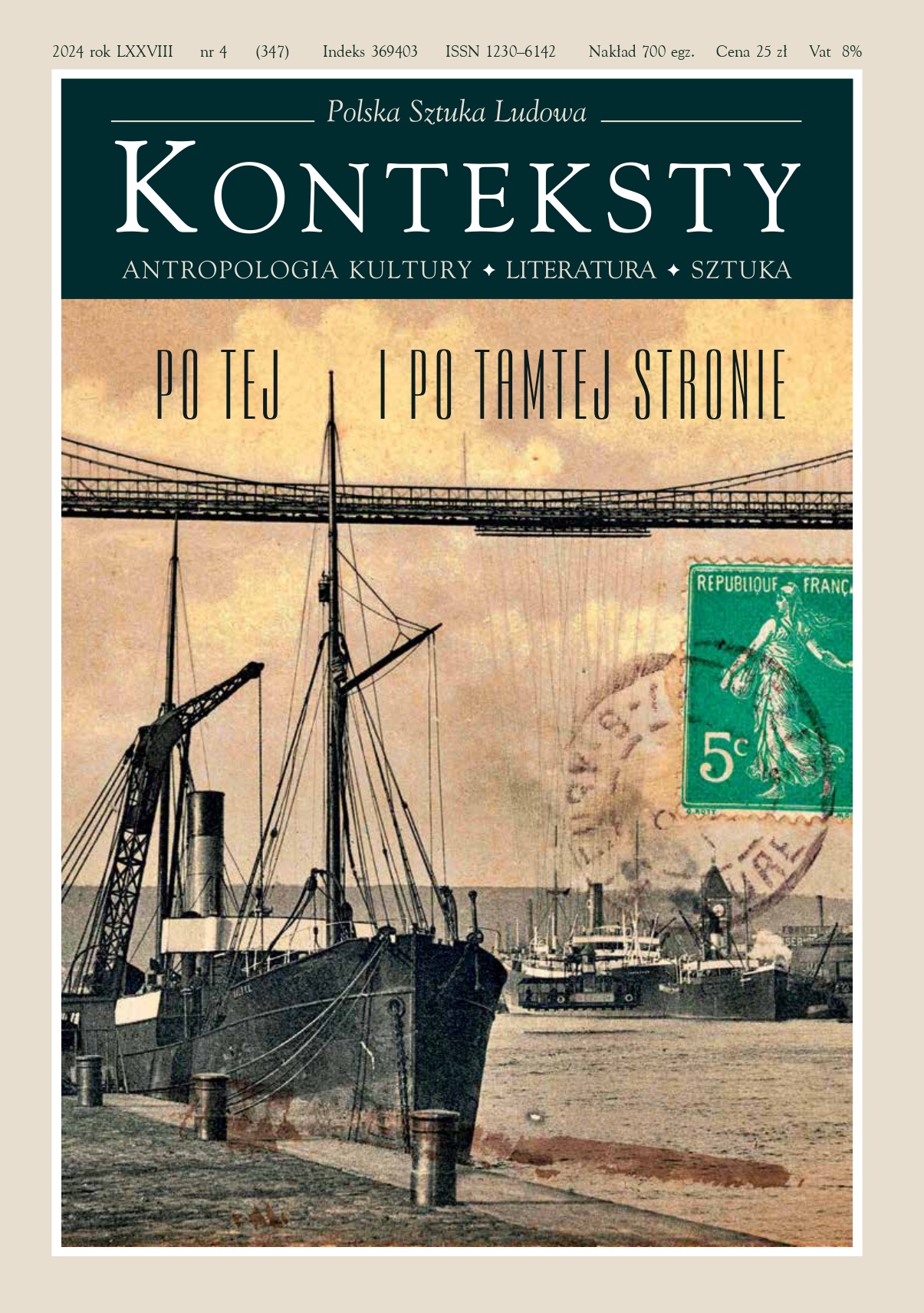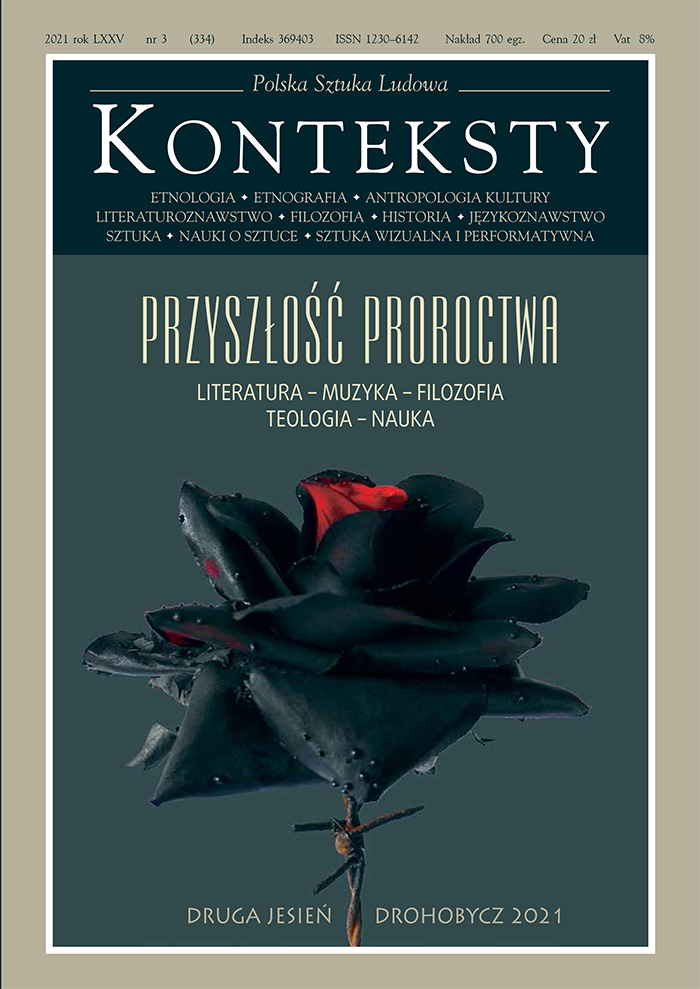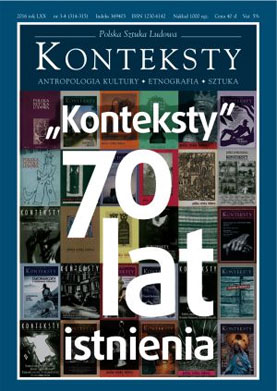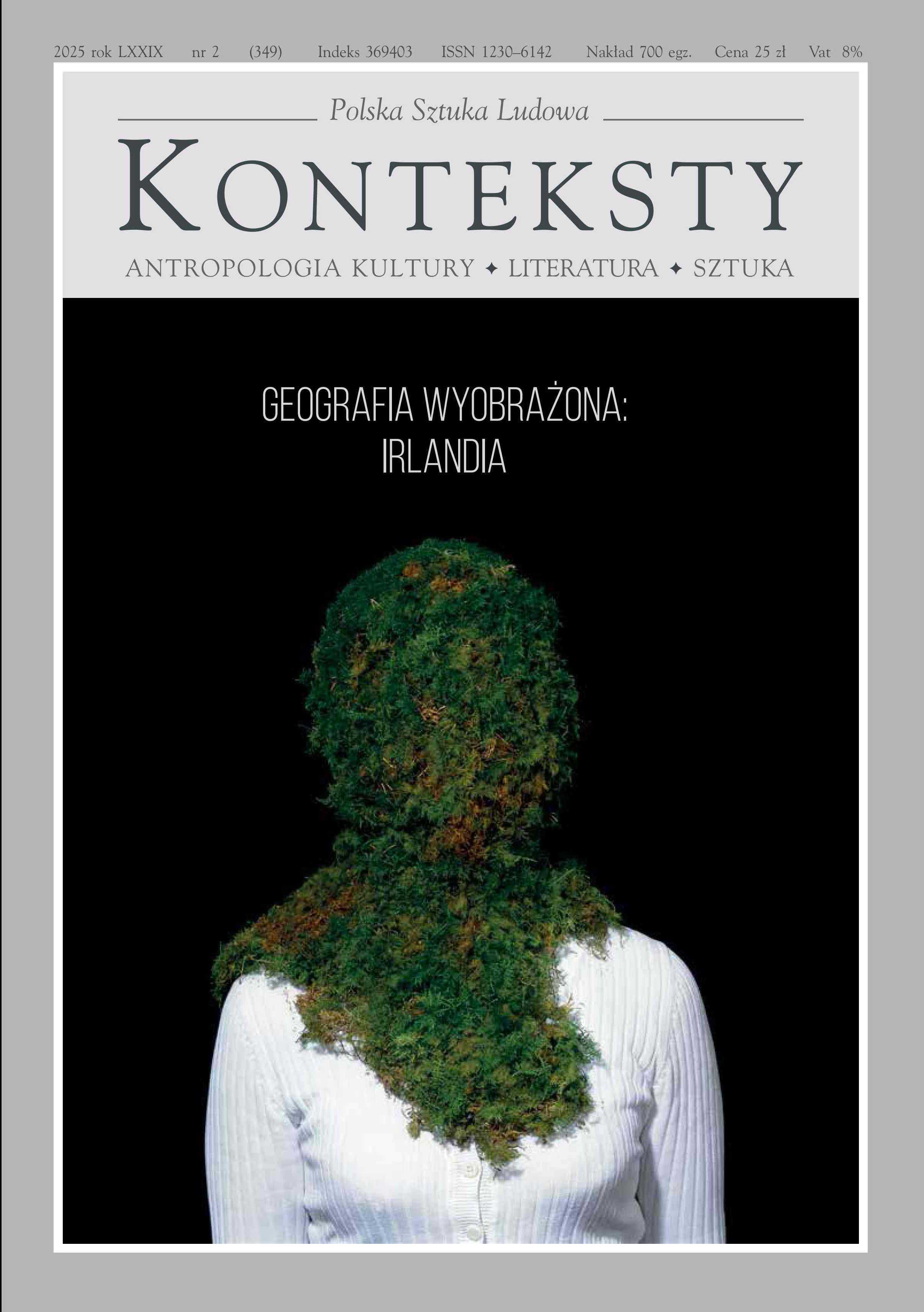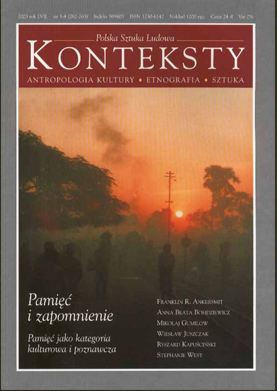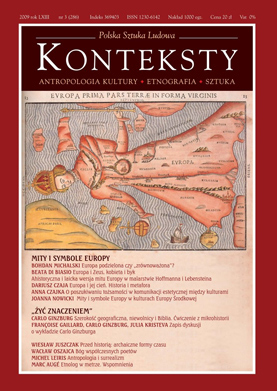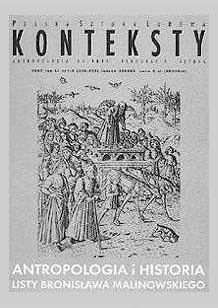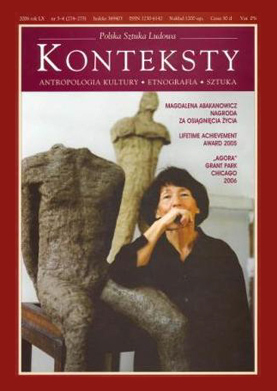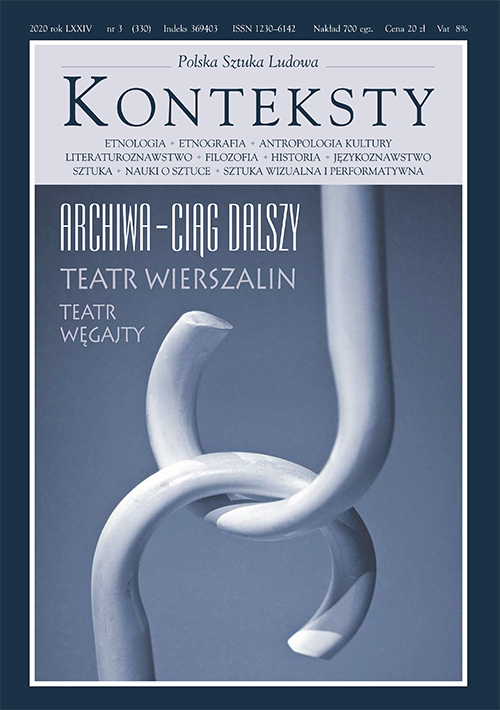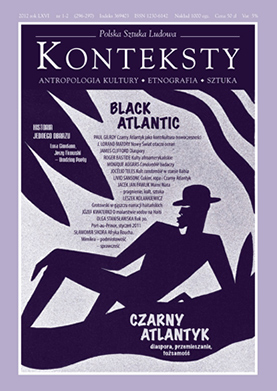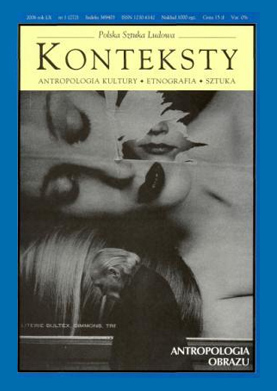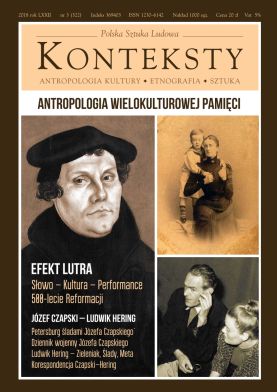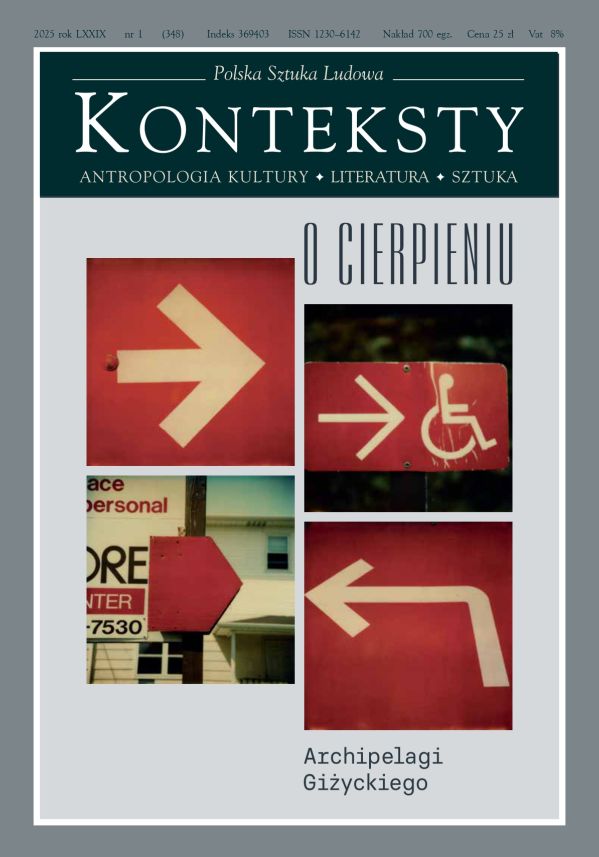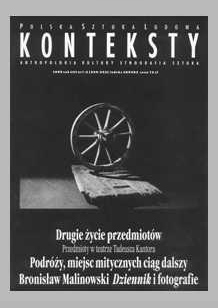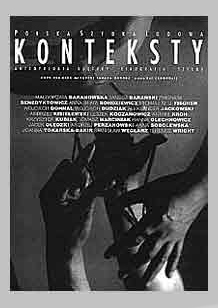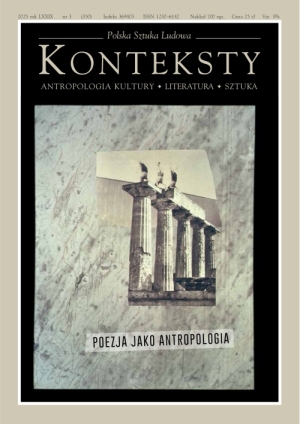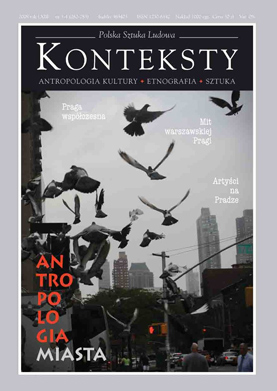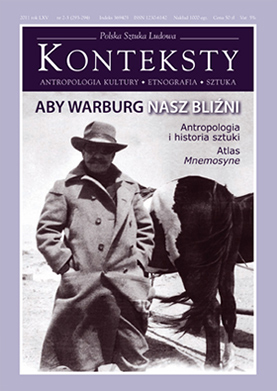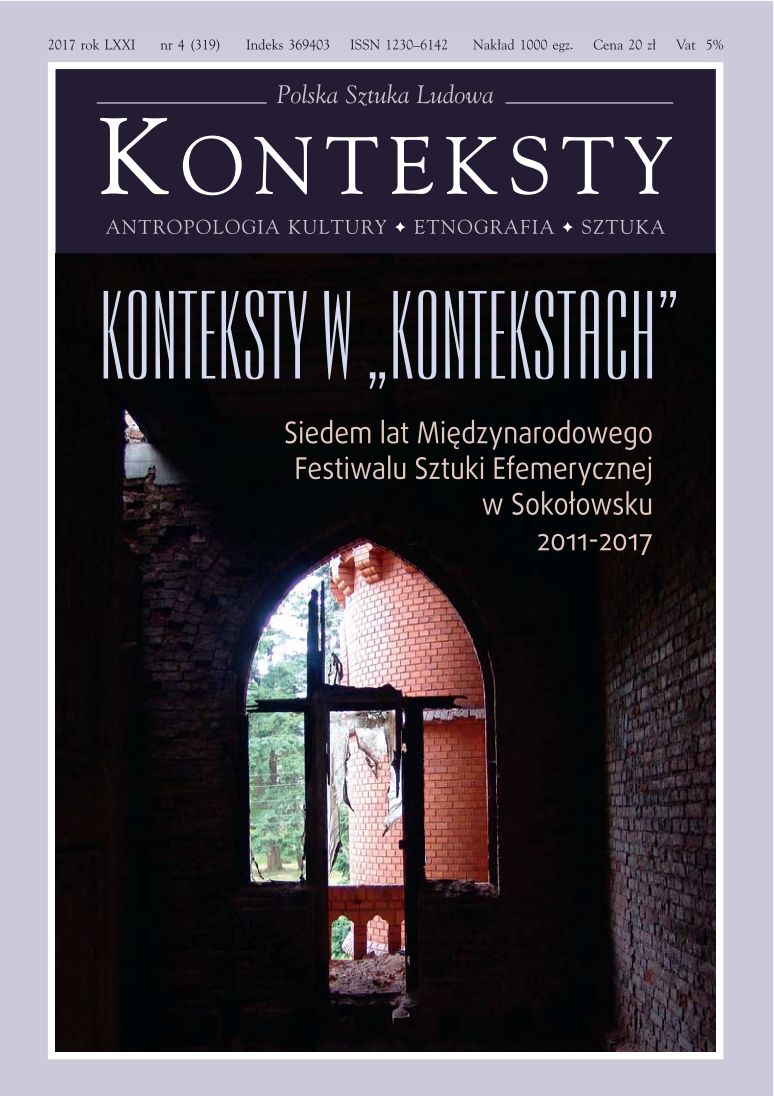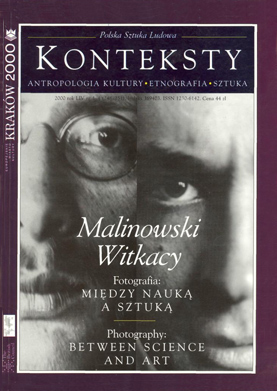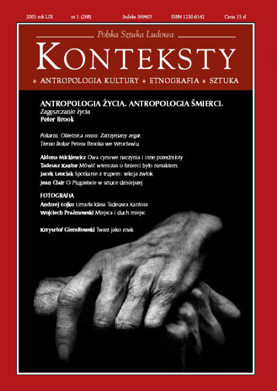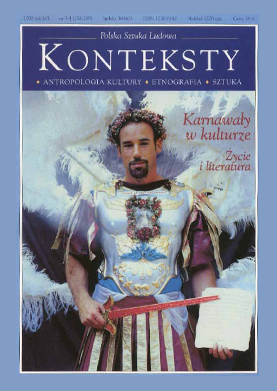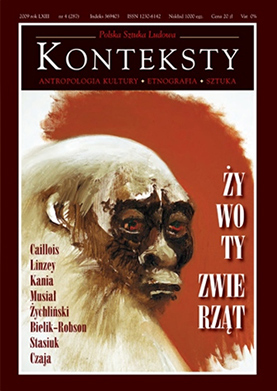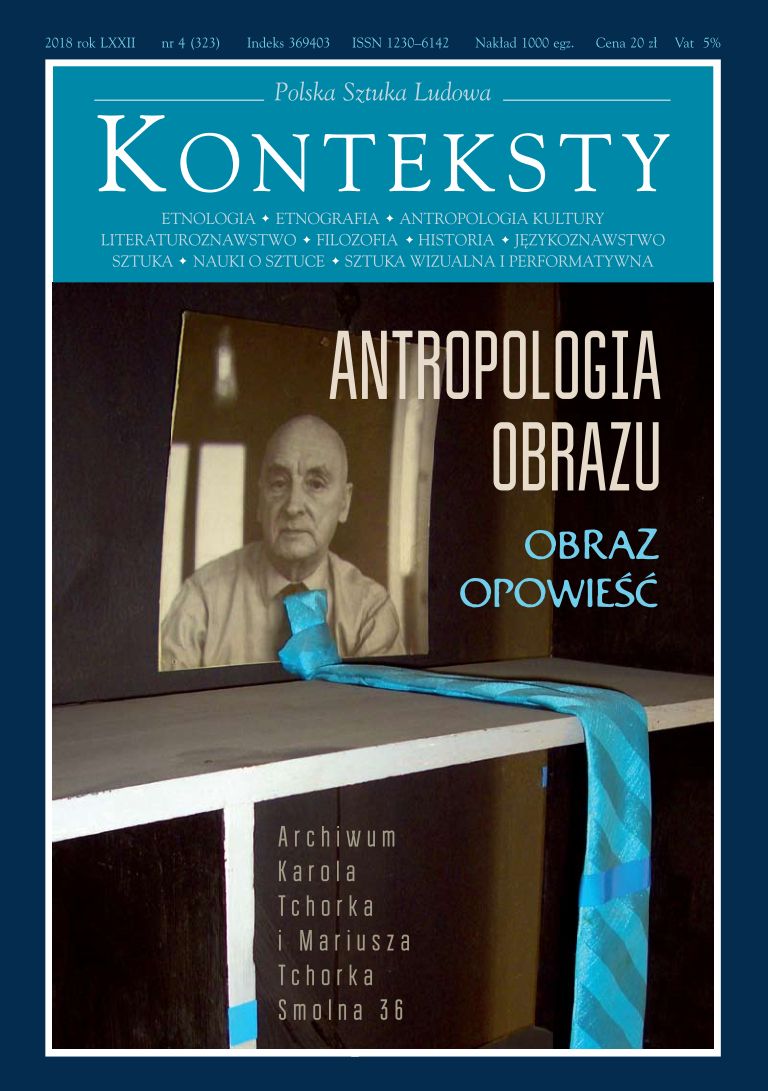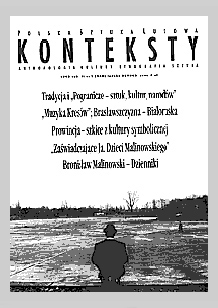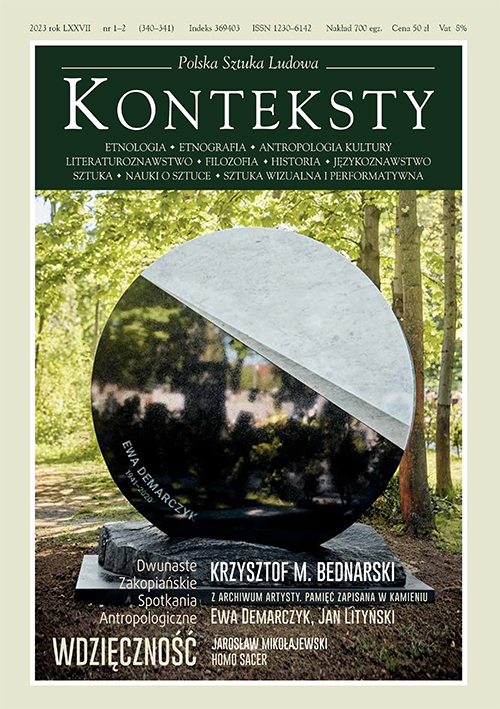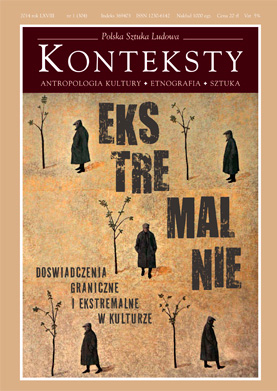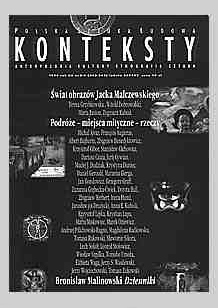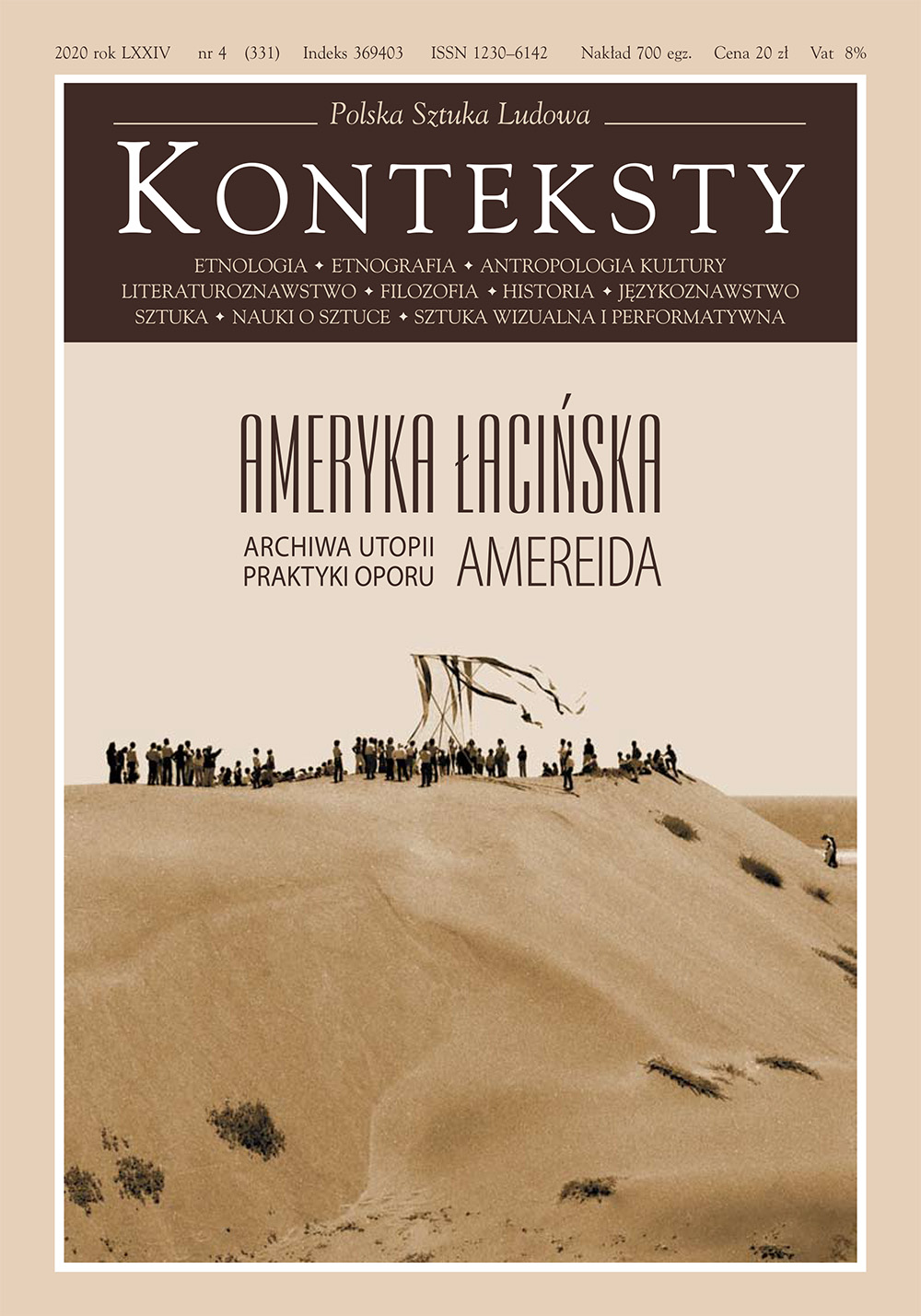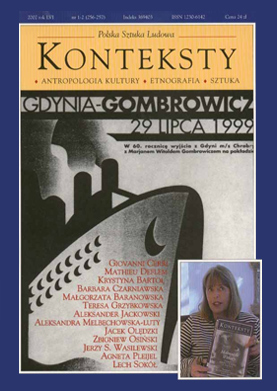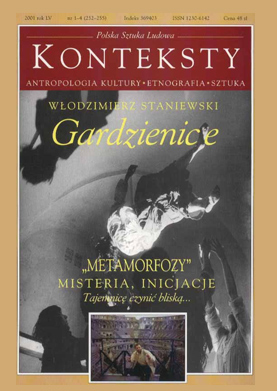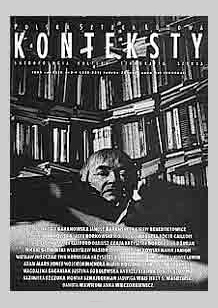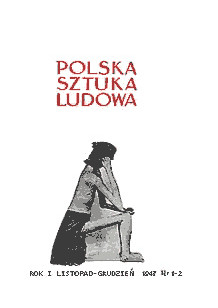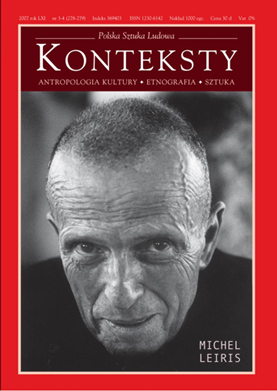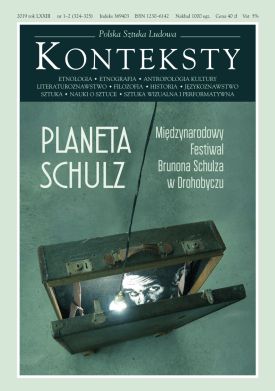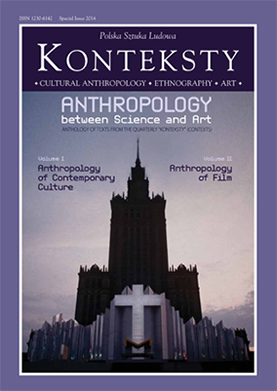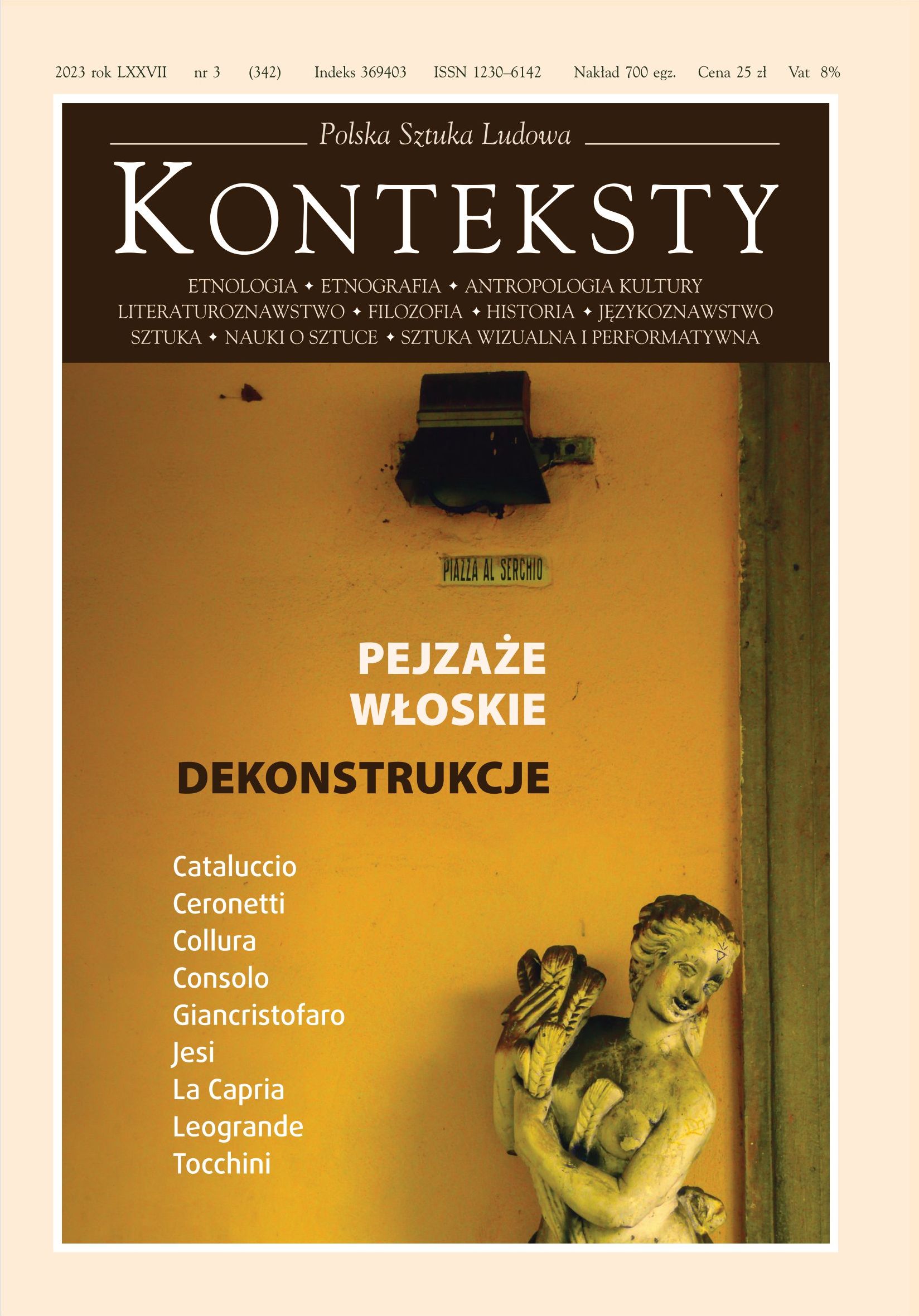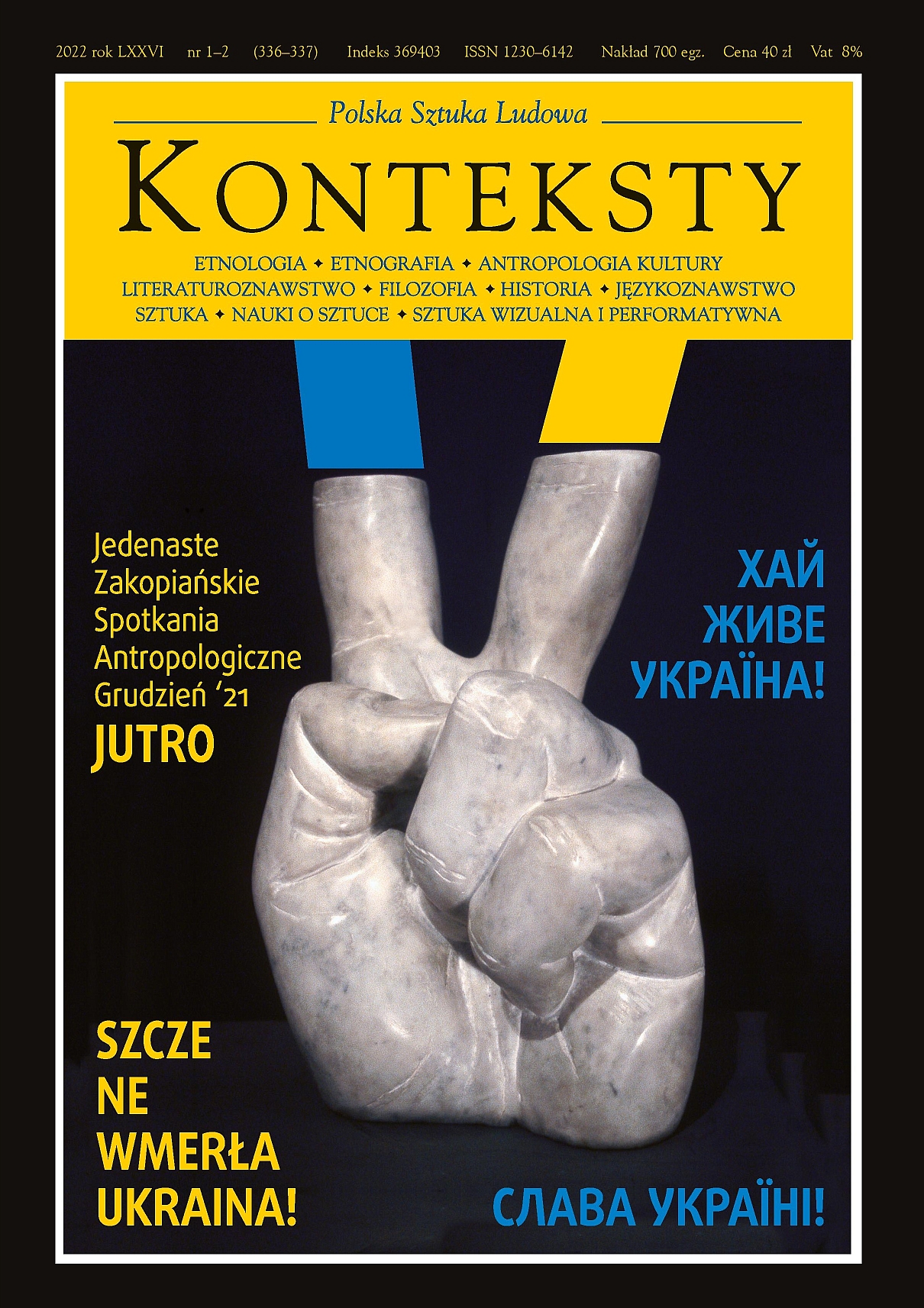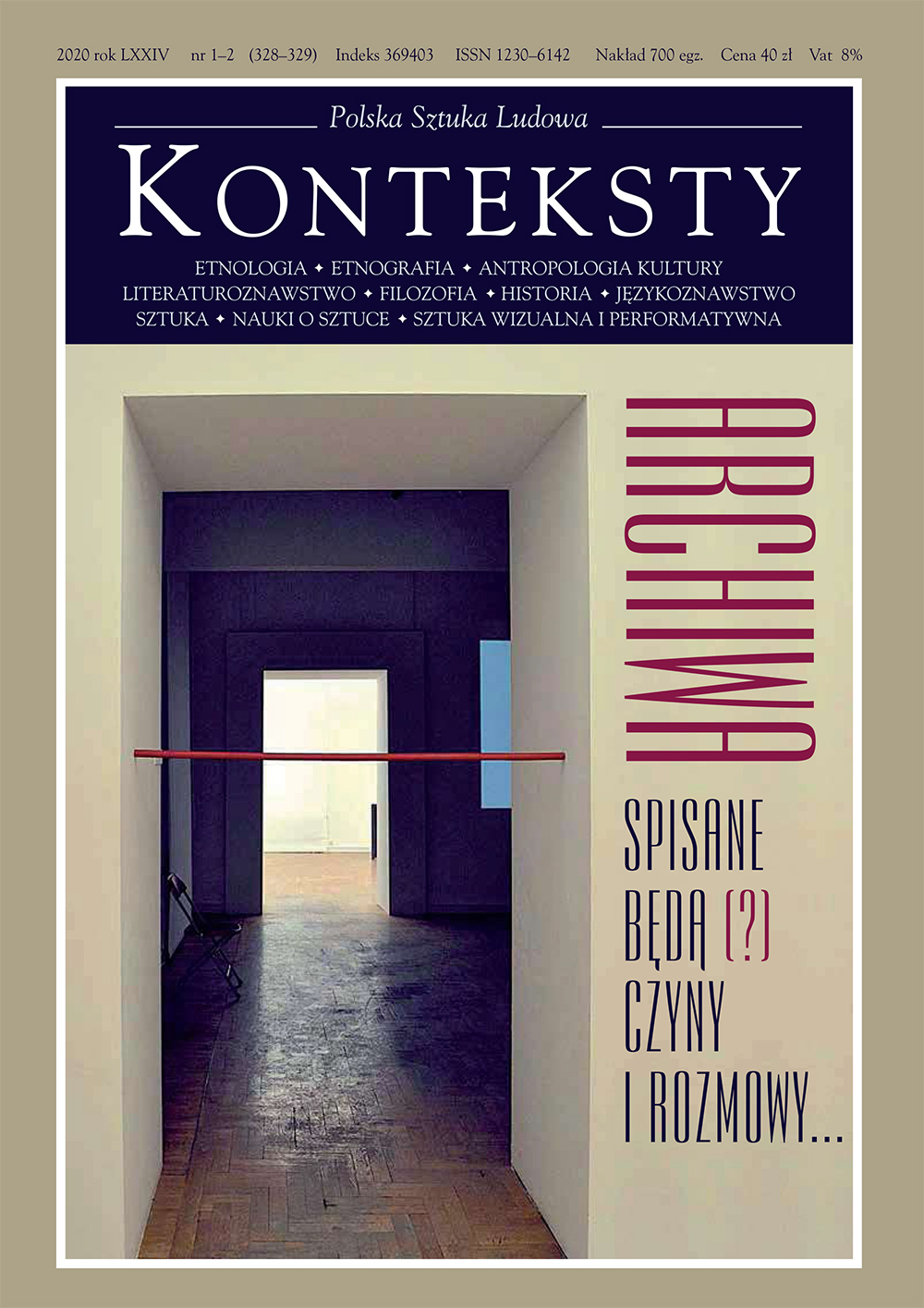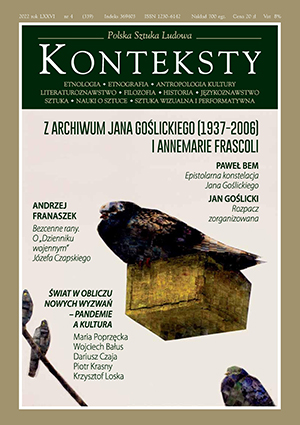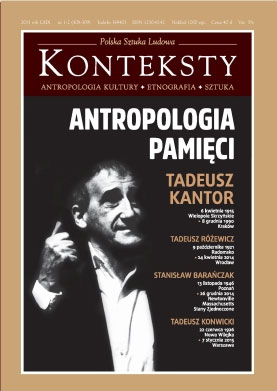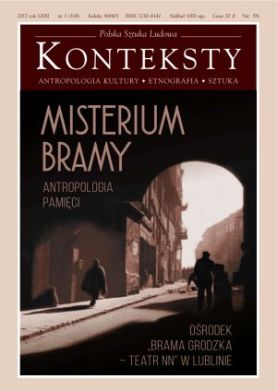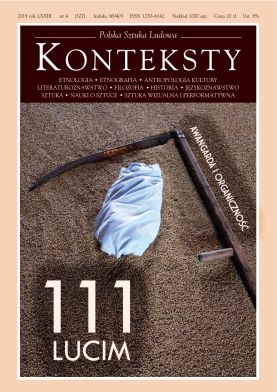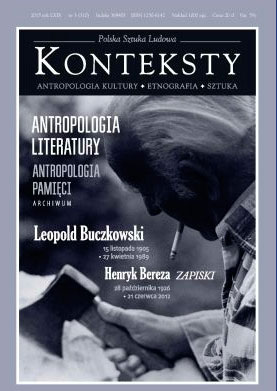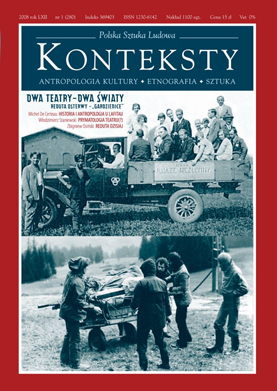Issue 2017/1-2 (316-317) - Konteksty rzeczywistości – rzeczywistość w „Kontekstach”
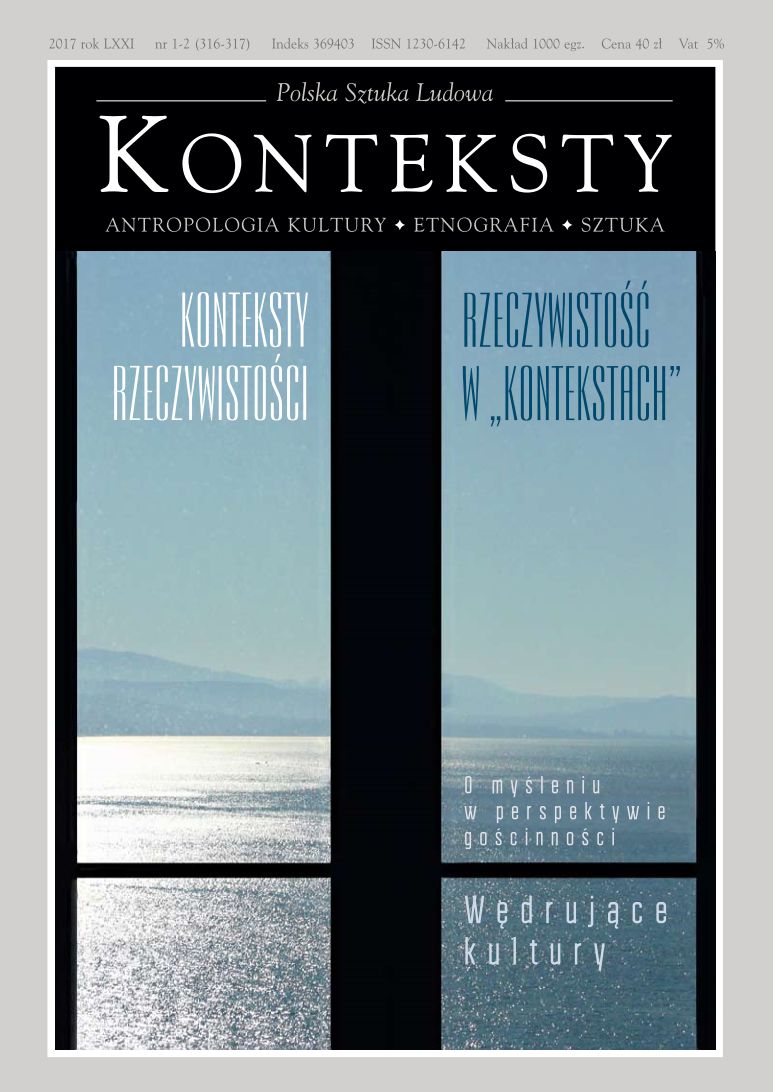
Read the whole issue online  | ||
Read the whole issue here | ||
| 70 Years of „Konteksty” | ||
| Zbigniew Benedyktowicz | Reality in the „Contexts” | 4 |
| Roch Sulima | “Descent” into Everyday Life | 6 |
| Ludwik Stomma | Daily Life as Normality | 10 |
| Maria Poprzęcka | The Fairy-tale Element in Mundane Daily Life | 12 |
| Anna Nasiłowska | Emancipation and the Economy of Modern Times | 16 |
| Danuta Danek | Nightly Anthropology  | 18 |
A presentation of discoveries pertaining to dreams initiated by the psychoanalytical studies concerning dreams, conducted at the turn of the nineteenth century by Freud, and in numerous instances confirmed today by neurophysiological research. In Poland, the pioneer of psychological investigations concerning dreams was the outstanding Julian Ochorowicz, whose manner of comprehending the significance of the dream was close to Freud’s findings. Upon the basis of examples provided by literature the author proposed metaphysical conceptions of the dream, whose ancient lineage is to be found in the history of culture, the metaphysical conception of dreams as well as psychological notions – precursors of the discoveries made by the author of psychoanalysis. An exemplification of classical psychoanalytical methods of understanding the meaning of dreams is an analysis of the so-called St. Petersburg dreams experienced by Mickiewicz, who considered them to be prophetic; at the same time, the article demonstrates the source of the allegedly visionary nature of this particular dream. | ||
| Contexts of Reality - Reality in the „Contexts” | ||
| * | VI Anthropological Meetings in Zakopane | 31 |
| Paweł Próchniak | Hospitality of Poetry on the Margin of a Song of Exiles  | 35 |
The author starts by recalling that the Polish national anthem – “Jeszcze Polska nie umarła…” (“Poland Is Not Yet Lost”), known also as Mazurek Dąbrowskiego (Dąbrowski\'s Mazurka) – is a song composed by and for exiles. For many of its actual protagonists the words: “Marsz, marsz […] do Polski” (“March, march [...] to Poland”) remained an unfulfilled dream. They died abroad and were buried in foreign graveyards, and now, according to the anthem lyrics, returned to Poland to lead the life (So long as we still live) of phantoms (a life that in many different ways was truly spectral). The author goes on to ask: can a poem offer refuge? Is poetry a form of hospitality? Can it provide asylum, just like Mazurek Dąbrowskiego takes in those exiles-legionnaires interred somewhere in distant lands and long forgotten graves? Instead of a solution – binding and expressed in simple words befitting soldiers – the author suggests two approaches to Polish poems about exiles (in France). The first is: Pogrzeb kapitana Meyznera by Juliusz Słowacki, and the second: Rue de Poitiers by Ryszard Krynicki. | ||
| Michał Klinger | The Biblical Definition and Mystery of the Fatherland  | 41 |
From its onset the Holy Writ (Deuteronomium – Prophets) is ”history” (Toledot): the history of the family of Abraham, the Nation of Moses, and the kingdom of David. The Covenant: the promise of the Land and the continuum of generations, leads through history. This ”Testament” confronts, also morally, the ethnic-historical reality of Others and strangers. The Law conceals a definition of the “fatherland” devised in the history of the Patriarchs, extremely universal and topical up to this day. From the time of the Tower of Babel, the actual experience of the fatherland and hope for the Land must be exclusivist (vis a vis the Semitic “brethren” – the Arabs) but morally and spiritually it confronts the ominous Mystery. All the ”messianic nations” must possess an identical (self-questioning) consciousness. | ||
| Stanisław Krajewski | Hospitality: between Abraham and the European  | 47 |
Individual hospitality is predominantly an ethical problem. This attitude, recommended in traditions, religions, and philosophical systems, is not always accepted by ordinary people. It does, however, remain an important point of reference. On the other hand, there is no unambiguous translation of the attitude in question into relations between groups, states, and nations. The problem at stake is well illustrated by examples from the history of the Jews – from antiquity to contemporary Israel. A wide background for the category of hospitality renders possible more in-depth reflections about the situation prevalent in Poland and present-day Europe. Fear of destabilization is natural and universal; people differ radically as regards, e.g. their assessment of the number of incomers, which could destabilise social order. | ||
| Janusz Bohdziewicz | Learn About Not-oneself Yourself. A Fragment of Xenoreflection  | 52 |
If the philosophy of the West (and the civilisation of Man) starts with stifling the Socrateian daimonion and silencing the voice of the Philosopher himself in writing – then it ends with Lévinas “splitting the atom” of the subject and a prophetic prediction of communication (upon the very threshold of the neo-media revolution). The intention of this text is to comprehend the “entanglement” of the subject in the light of assorted contemporary discoveries and investigations. The point of departure is a simple intellectual experiment, subsequently interpreted in ten various contexts. The article is inspired by diverse philosophical sources (Agamben, Heidegger, Lévinas, Nancy, Ricoeur, Wodziński), but also by those found within the realm of assorted sciences (Gazzaniga, Heisenberg, Jaynes) and in particular the media theories (Havelock, de Kerckhove, Taylor, Ulmer). A description of the conclusions drawn from this reflection within the concepts of host / guest and hospitality / guest-the other leads towards a more in-depth discovery of a common field for the possible arrival at “such a You in which there is no I”. | ||
| Dariusz Czaja | The Enigma of the Image. Art and Hospitality  | 60 |
An encounter with a great work of art (and in this case this is the only kind I have in mind) always has an underpinning involving risk and uncertainty. Participating in such an encounter we are exposed to the different, the alien, and the unknown. Uncertain, we thus drift between fascination and fear. We are no longer at home and become guests in a “strange” land, but also hosts in relation to that, which is not ours. We enter a work of art, but the latter does the same in relation to us. Sciences dealing with art do much to tame and name that unclear and mysterious encounter and to eliminate its peculiarity with the assistance of learned speech. But that which is the most important appears to evade them. | ||
| Małgorzata Sady | Łańcut Castle Opens Its Hospitable Doors to the Quay Brothers  | 68 |
Inventorium of Traces, a film by the Quay Brothers, masters of puppet and object animation, depicts a quest for the presence of Jan Potocki at Łańcut Castle. It was made thanks to unusual coincidences as well as the kindness and sympathy of people and the world, resulting in a “cinematographic” book and the motion picture: Alfred Schreyer from Drohobycz, and generating a number of further consequences. | ||
| Katarzyna Prot-Klinger | The Host-guest Relation in Inter-war and Present-day Poland  | 78 |
Polish-Jewish relations spanning from the interwar period and wartime to the present served the author as material for reflections concerning social relations between the guest and the host. In doing so, Katarzyna Prot-Klinger dealt with a particular Jews-Poles formation, the axis of the article being the history of her Jewish family. The text demonstrates how the figure of “the Other” – “the guest”, who feels at home and wants to resemble the host, was and continues to be regarded as a threat to Polish society. In the conditions of a crisis a group begins to function according to principles described by Bion as “basic assumptions”. While examining society conceived as a group one may observe how the mechanism of the “scapegoat” becomes activated. “The guest” (Jew / refugee) represents and supposedly stores the unwanted elements of the host, thus rendering any closer proximity between them impossible. | ||
| Kuba Szpilka | Harnasie  | 85 |
Examples from Zakopane showing that togetherness does not require enlightenment. Bartuś Obrochta, Karol Szymanowski, and “Zakopane want only enjoying life” with a small pinch of Hannah Arendt. | ||
| Magdalena Gubała | Empty Place  | 89 |
This sketch briefly outlines the theme of musical improvisation considered in Internal Ear, a musical documentary by Magdalena Gubała and Szymon Uliasz (2016). The context consists of reflections by Tadeusz Sławek (in particular the “cautious hospitality” formula and the Derridean ”unlimited hospitality” formula) and Cezary Wodziński (the Hospitality formula). The text also refers to inviting the Other to share a place at a table, envisaged as a possibility of meetings and conversations, not only musical, within the open-attitude gesture. Internal Ear is a sui generis musical film essay, and the author of this text (who is also the film’s co-director) brings the reader closer to the essential aspects of thinking about it and the circumstances in which it was created. | ||
| Jerzy S. Wasilewski | “Guest in House… Worse than a Tartar”. The Ethnologist and the Hospitality Aporia  | 93 |
The title of the article is a combination of two popular Polish proverbs, with the first declaring that a guest is a form of godliness, and the second – that hospitality is torment; both attitudes are widely represented in paremiology since each is in its way justified by reality. What do the eternal symbols of the godliness of the guest, the other, the stranger actually mean, especially today, in an age of mass-scale influxes and migration? Was the guest really treated as a representative of the sacral / superhuman and the transcendent, or was this rather at best a metaphor of his inviolability? The text discusses various historical and ethnographic materials documenting the attitude in question. The problem of sexual hospitality is considered more extensively; apparently, the anticipated element of the guest’s sacral status does not occur in this custom, rather universal in the ethnographic past of various societies, and its local motivations and emic justifications are exclusively social. | ||
| Jan Szpilka | Guest at an Anthropological Meeting. On First-hand Experiences of Hospitality  | 103 |
An essay about an anthropological meeting, which showed how it is possible to think about the world as myriad assorted forms of hospitality – without hospitality and encounters there is no world of interpersonal questions. | ||
| Tomasz Szerszeń | Images of Homelessness, Homeless Images Europe 2017: Constellations  | 106 |
In one of his letters written in 1937 the émigré Walter Benjamin mentioned the encroaching future as “a time to dream about a bombproof shelter”. Today, those words are becoming disturbingly topical. Once again, just as during the period of Benjamin’s enforced emigration, the question of literal and metaphorical homelessness, the absence of a home, the search for a haven and associated hospitality (or its lack) returns both as a figure and a concrete, individual experience. Tomasz Szerszeń would like to take a closer look at this problem via the experiences of his voyages: to Kharkiv, an important cultural centre along the Ukrainian-Russian border, a city of “vagabonds and poets”, and to the Greek island of Samothrace, the historical site of the Kabir mysteries and today an island of “defectors from civilisation” and “inner émigrés”, situated close to the transit routes followed by refugees sailing from Turkey. In both cases the real experiences of homelessness and seeking asylum appear within the context of images – photographs and films – connected with those concrete places. What is the relation between homelessness and hospitality? Can images render this complicated union? And finally: can photographs and images as such be homeless or hospitable? The frame for this dissertation is documenta 14 that takes place in Athens (2017), as well as Jacques Derrida’s essay Of Hospitality and Paul Virilio’s project Bunker Archeology. Finally the text creates a sort of Benjaminian constellation or cartography of Europe in crisis anno domini 2017. | ||
| Wojciech Michera | On Thinking in the Perspective of Homelessness. Daidalos, kharis, ikelos  | 121 |
Although the ethics of “hospitality” alleviates the outcome of ethics based on separating from and resisting otherness, the object of our concern remains the identity of the host. The author – while acknowledging that the as if source figure of the “incomer” is a woman reflects on the possibility of crossing such a perspective: in doing so he seeks symptoms of such a manner of thought, which treats “otherness” not as the effect of the appearance of the “guest” but as a primeval state. In the second part of the article this conceptual model is in particular the Greek conceit of daidalos – a special image created according to a modern intellectual model based on separating and putting together, whose visual effect is scintillation, connected with such categories as: kharis and ikelos. | ||
| Wandering Cultures | ||
| * | Wandering cultures | 131 |
| Paweł Kuligowski | Tackling Odyseus. An Essay on the Surplus of Experience  | 135 |
The presented essay is a portrait of the arch-hero of The Odyssey envisioned as the arch-hero of modernity: a hybrid protagonist, flawed, and – just as modernity itself – highly unsatisfactory. The more general backdrop for the thus conceived portrait is a deficit of the actual form of the Western heroic myth and, in particular, its inability to reproduce Western axiology. Odysseus followed the same path as Achilles and, subsequently, Christ, but never reached the same destination. His return to Ithaca (nostos) is just as doubtful, interim, and ambiguous as his glory (kleos). | ||
| Łukasz Stypuła | A Permanent Exodus  | 153 |
Agata Bielik-Robson wrote that the myth of the Exodus is becoming the most important myth of our culture and a figure of mass departure towering above all its counterparts. Upon what sort of a base does this migration take place? Is the Biblical text contained in The Book of Exodus still topical? When does migration start and end? By deploying the legendary figure of the Wandering Jew condemned to eternal roaming and a permanent existence on the road, the text spans from the Biblical Eden, the leading of the Jews into the desert, and the mediaeval Aggadah all the way to present-day Israel so as to present the essence of the category of mobility and the nomadic quality contained in Biblical symbols of the Egyptian enslavement. | ||
| Magdalena Barbaruk | Don Quixote. To Wander into Modernity  | 160 |
On a certain July morning four centuries ago Don Quixote decided to leave the house in which he had spent almost fifty years. On the very same day he resolved to wander across the world on a quest for adventures. His journeys were by no means a travail to which he had been condemned by a verdict passed by someone. Nor did he vanish without a trace or from the very onset wished – in the manner of Odysseus – to return home. This was a radically different journey. “The wandering will annihilate Don Quixote, but earlier nothingness will produce reality” (Janusz Węgiełek). What sort of a model of reality and our existence in the world is, therefore, the outcome of this journey? Why did the knight on his solitary way along a La Mancha trail become the founder of modernity, in which we continue to recognise ourselves? | ||
| Marek Pacukiewicz | “The Darkness of a World of Illusions”. Conrad’s Colonial Landscapes  | 168 |
The complexity of the colonial discourse in the works of Joseph Conrad has been the topic of multiple discussions, but the key to deciphering the problem consists of the manner in which the writer constructed the landscape. In this particular case we are dealing both with enormous frescoes, such as the ones encountered in The Heart of Darkness, and with extremely intimate landscapes, which appear to be the outright leitmotif of such short stories as The Lagoon. The landscapes in question are not reduced exclusively to the function of a backdrop since each comprises a structural model of the world and takes into account the dynamic of a variable, intercultural perspective – a clash of divergent taxonomies. The change of viewpoints applied by the author emphasises the role played by the cultural context conceived as the stuff of the colonial system. | ||
| Jacek Ziemek | From Ellis Island to Beverly Hills. The American Cinema and Incomers from Everywhere  | 177 |
“At Ellis Island I was born again. Life for me began when I was 10 years old” – thus said Emanuel Goldenberg vel Edward G. Robinson, born in 1893, who landed on the island in 1903 and became one of the most despicable gangsters in Hollywood film productions. Many of those who alighted on this small island subsequently disembarked on Beverly Hills, and by becoming stars of the American cinema simultaneously turned into immortal heroes of mass-scale imagination or outright co-created the latter: Antonio Moreno, Joe Hill, Al Jolson, Frank Capra, Claudette Colbert, Johnny Weissmuller, Elia Kazan, Bela Lugosi, Rudolph Valentino, James Wong Howe… In a word: from Dracula and jazz singer to Tarzan. The author intends to reflect on their original cultural identity, ways of creating an awareness of existing in a new, American social space, and aesthetic signs of cultural confrontation visible in the cinematic record left by them. He also plans to follow émigré semiotic activity, mobility of meanings, and existential adventures experienced by film stars in the American promised land – spanning from The Immigrant (1917) directed by Charlie Chaplin, Bo Widerberg’s Joe Hill (1971) to The Immigrant (2013) directed by James Gary. | ||
| Stanisława Trebunia-Staszel | This is Florida Voivodeship – Here’s No Winter and No Snow. The Podhale Highlanders Travelling to the Land Beyond the “Great Water”  | 183 |
The author attempted to follow the phenomenon of “wandering cultures” by evoking the experiences of émigrés from the Podhale region who in the course of the past century reached the ”American paradise”. The point of departure for the presented reflections is composed of letters written by the highlanders at the beginning of the twentieth century and the experiences recorded therein as well as those resulting from a confrontation with the new reality of “great America”, so different from their native Tatra Mts. An acquaintance with those autobiographical accounts–confessions makes it possible to take a closer look at the inner world of the émigrés as well as at the problems and challenges, which they were compelled to tackle at the onset of a life in a new country ”across the great water”. | ||
| Anna Niedźwiedź | A Glimmering Map – towards the Anthropology of the Pilgrimage  | 191 |
The titular “glimmering map” serves as a metaphorical image illustrating contemporary anthropological studies dealing with pilgrimages as well as their ethnographic and theoretical foundation. Today, these once stable and lucid categories are depicted in anthropological studies as remaining in motion and not defined to the very end, as in the case of the categories of “religion”, “holy site”, and “pilgrimage”. The presented text proposes a review of historical and contemporary anthropological publications pertaining to the pilgrimage and illustrates flourishing studies about pilgrimages – a reflection of interest in the mobility, fluidity, and creativeness associated with motion. With key theoretical works as the point of departure the author refers in particular to such questions as: the categories of communitas, contestation, mobility, the polyphonic quality of space, and the part played by the body and sensory experiences in the pilgrimage process. The text also considers questions connected with the pursuit of ethnography and the stand taken by the anthropologist while studying pilgrimages. | ||
| Jarosław Mikołajewski | Wandering: a Poor Metaphor, an Even Worse Reality  | 205 |
Life, breathing, and translation are a form of wandering. Even wandering is wandering. Is it possible to think of wandering and the journey in categories and states other than the transposition of wandering into something, which it is not? | ||
| Dariusz Czaja | Mare nostrum, mare monstrum  | 209 |
The inhabitants of the Mediterranean Sea coast used the description: “our sea”. Already in ancient Rome its customary name was: mare nostrum. In turn, the Greek Mesógeios and the Latin Mediterranean meant: “sea between the lands”. This “between” quality became the source of creative metaphors. For centuries the Mediterranean remained a “crossing of cultures”, an “arena of exchange”, a “melting pot of civilizational encounters”, etc. It was the essence of life, energy, and vitality. The vessels crossing it carried on their decks merchants, soldiers, pilgrims, missionaries, and voyagers. Today, the Mediterranean is, at time, also an area of yet other sorts of transition. For people fleeing their countries in order to find refuge against war and poverty mare nostrum has become a source of hope; for many it also turned out to be a dead sea. | ||
| Paweł Drabarczyk | Self-portrait with a Car Crash  | 220 |
When you invent the car, you also invent the car crash – Paul Virilio convinced his readers. It turns out that to invent the automobile means also to turn upside down or, at the very least, to question the heretofore aesthetic, symbolic, and spatial order and even the order of experiencing the sacrum. Marinetti regarded the roaring automobile to be more beautiful than Nike of Samothrace. Several decades later Barthes recognised the automobile to be a counterpart of Gothic cathedrals, an object that has “fallen from the sky”. In what sort of condition does the car reach the period of late modernity? What remains today of the former enthusiasm? How alive are the foundation mythologies? Are we already witnessing the twilight of goddesses, and should the motif of the car crash, recurring more and more often in pop-culture and the arts, be interpreted as a new form of iconoclasm? | ||
| Krystian Darmach | An Anthropological Servicing of an Airplane  | 228 |
With the help of anthropological categories and tools I shall “take apart” an airplane so as to put it together again and view it as a key for comprehending global processes of the contemporary world: the role of innovation, invention, and technology in the cultural activity of man, as well as its impetus and influence upon life within a daily, local, global, etc., dimension. I wish to show the airplane as a site, a flying modern museum, a space of free thought and invention seen as the arch-human attribute of man. The airplane and the airfield will be treated as links in the evolution of widely understood communication brimming with borrowings, interferences, and inventions. | ||
| Magdalena Zych | Wanderlust. A Return to Walking  | 235 |
The article brings the reader closer to reflections about walking comprehended as a cultural praxis. The author refers to publications by Rebecca Solnit, Robert Macfarlane, and Tim Ingold. In doing so she delves into circumstances in which walking is interpreted as a conspicuous attitude towards the world, making it feasible to build more profound relations with the surrounding. | ||
| Małgorzata Sokołowska | The Netsuke Phenomenon. On Wandering Objects  | 242 |
Things travel together with people. They are also the topic of Edmund de Waal’s The Hare with Amber Eyes, which became a point of departure for the below presented reflections about the unity of objects and cultures. De Waal depicted the history of his family from the viewpoint of a shifting collection of netsuke – miniature Japanese sculpted figurines. Thanks to this approach we may observe political and cultural transformations across the centuries and ponder on the role they play in the daily life of things, which, for artistic, historical or sentimental reasons, are recognised as special. Netsuke constitute a fascinating fragment of the history of wandering and the relocation of objects and meanings that link the East and the West. | ||
| Monika Bułaj | Quando gli dei si parlano  | 253 |
Fragment of the author’s text: “I travel alone because solitariness without any filters and covers is indispensable in an encounter and always remains a path leading towards people and amongst them. True, I have my loyal companions: hurriedness and the fear that I shall not be on time. Sometimes, I am late. Or perhaps I map sites to be eliminated? They prove to be too fragile not only in the face of phantasmas but also of popularity transforming holy places into the amusement parks of photographers. It is thus better to obliterate names, dates, and trails, to use invisible ink for writing key words on this unearthly map, which ignores walls raised by the preachers and protagonists of the global brawl. From the very heart of Asia to Latin America, from the Maghreb to the Middle East, from the source of the Nile to the mouth of the Onega. Wherever signs, presences, gestures, and glances emerge from the shadows of monotheism. This means Africa, or rather many Africas, with its gods exiled in the manner of people, the womb of the last living archetypes, where religiosity, in other words, literally a bond, is created in mutual contact between the living and the dead, an endless conversation with ancestors. Places where words are not separated from things, and which are inhabited, just like ancient Greece, by deities created in the shape of man”. | ||
| Tadeusz Kantor. Marionette | ||
| Małgorzata Paluch-Cybulska | Tadeusz Kantor. Marionette. A Post-conference Discussion  | 259 |
The Tadeusz Kantor. Marionette conference held at the Cricoteka Centre for the Documentation of the Art of Tadeusz Kantor in Cracow on 12 February 2016 involved an extensive discussion, whose participants, apart from the authors of the presented papers: Dr Dominika Łarionow, Dr Karolina Czerska and Dr hab. Tadeusz Kornaś, included such eminent scholars and experts on the works of Tadeusz Kantor as: prof. Katarzyna Fazan, prof. Dr hab. Włodzimierz Szturc, Dr Zbigniew Benedyktowicz, Dr Anna R. Burzyńska, Dawid Mlekicki, Małgorzata Paluch-Cybulska, Anna Kapusta, and Jan Güntner, an actor of the Cricot 2 Theatre. In the course of the discussion particular lectures became expanded by introducing the following problems: is it suitable to apply to the Strawman dramatis persona from Wyspiański’s Wesele (The Wedding) the “rites de passage” conception proposed by Arnold van Gennep? Other discussion themes included: broadening the context of the brides in the theatrical productions of the Cricot 2 Theatre by means of the Bardzo krótka lekcja (A Very Short Lesson) cricotage and references to Russian symbolic tradition; the symbolics of the bride in Doodri, Doodri (2007), a spectacle shown by the Changpa theatre company (South Korea); an anthropological comparison of Kantor’s ritual brides with the “ritual of marrying death” from Lesser Poland; a comparison of the White Emballage (the emballage of the bride) in the first version of the spectacle Nigdy tu już nie powrócę (I Shall Never Return) with the phenomenon of the emballage conceived as a screen or a diaphragm electrifying the space around the actor on stage; the expansion of reflections on the motif of the cross in Wielopole, Wielopole by introducing the rhythm of linking the ritual with the space of the stage – an analysis of potential references to the Passion Play in Kalwaria Pacławska and the Holy Week Mystery Play; the motif of the cross in the Cricot 2 Theatre with an inscribed act of balancing between blasphemy and the sacral; the construction of poising assorted elements of the spectacle: Wielopole, Wielopole; the process of widening references to Christological contexts in the works of Tadeusz Kantor. | ||
| Karolina Czerska | The Untimely Wedding – Brides in the Theatre of Tadeusz Kantor  | 263 |
The author analyses assorted versions of the bride occurring in selected spectacles by Tadeusz Kantor by closely following the evolution of this motif, significant in Kantor’s oeuvre. The article also focuses on the status of the Kantorian mannequin, changing in the course of successive theatrical realisations and described upon certain occasions by the artist as a “puppet” or a “wax figure” that could function as the actor’s “companion”, his sui generis prolongation (similar to the bio-object), a supplementary doppelganger or a model of the actor’s performance. Within this context references to the symbolism of Blok or Maeterlinck assume an essential rank as does situating the dramatis persona between life (actor) and death (mannequin and its variants) as well as the consequences of such a borderline quality for the staging. | ||
| Tadeusz Kornaś | Mannequin on a Cross an Analysis of a Single Prop – the Great Cross in Wielopole, Wielopole by Tadeusz Kantor  | 270 |
The spectacles proposed by Kantor produced a powerful tide of religious and liturgical motifs. It is outright astounding that they had been discussed so rarely as an intrinsic theme worthy of a closer examination. At every step of the way Wielopole, Wielopole is full of crosses. Can we, however, pause only to declare that this is a lower rank reality? Naturally, we could do so. Kantor himself suggested this solution: “I was raised at a presbytery. I was familiarised with all activities and objects. They are the same for us. Even this object – the Cross – for me is an object like... well, my table in the new studio”. Nonetheless, if we take a closer look at Wielopole, Wielopole we shall come across innumerable references to liturgical ceremonies (in particular the “stations” of the Cross). It becomes, for all practical purposes, impossible to believe that everything is a “table in the new studio”. True, the Theatre of Death is just that but even at the simplest level the associations made by every spectator, even unconsciously, follow a further path. Obviously, the Cross was the instrument of the Passion and Death of the Christ, but we cannot forget that without the Resurrection it would have remained a mere empty symbol of a two millennia–long history of Christianity. Its application in the Theatre of Death cannot be meaningless. Even if Kantor were to have deprived it of all sacral connotations it would still be some sort of a theological feature referring indirectly to transgressing the condition of death. The presented text is, therefore, an analysis of meanings associated with the use of the great Cross in Wielopole, Wielopole. | ||
| Dominika Łarionow | Liminality upon the Example of Works by Stanislaw Wyspiański and Tadeusz Kantor. An Image of Complementary Ideas  | 277 |
The article presents two artists: Stanisław Wyspiański and Tadeusz Kantor, who in their works applied the idea of liminality so as to describe their psychic states and attitudes towards art. The titular liminality is conceived in accordance with the theses propounded by Arnold van Gennep. At the same time, the discussed authors were not interested in rite de passage as a ritual derived from folk qualities but were fascinated solely by the moment of suspension, i.e. a liminal situation, without proposing its unambiguous solution. The author commenced her analysis by considering the Strawman dramatis persona from Wyspiański’s play Wesele, which the playwright employed to introduce into Polish art an interest in liminality as a state of suspension. An inevitably cursory analysis demonstrated the extent to which the introduced straw character differed from the aesthetic norms and canons of the period and became a highly unique creation that throughout the whole twentieth century intrigued and inspired various authors. Tadeusz Kantor, who was enthralled by Wyspiański, borrowed the latter’s predilection for liminality, which he put to a different use. The dissimilar character of the approach to rite de passage was, in the case of both artists, the outcome of different experiences, not merely aesthetic but also personal. The individual life story of both men generated the necessity of a different comprehension of death, dying, and illness and thus self-perception vis à vis the world. Liminality, which the Young Poland-era poet found so fascinating, turned into an extremely capacious category, making it possible to perform certain transgressions in art. The author attempted to demonstrate the way in which Kantor made use of liminality by treating it slightly perversely or irreverently – on the one hand, by resigning from the Strawman’s straw and, on the other hand, by standing on the threshold of illusion and disillusion. | ||
| Katarzyna Fazan | Artificial Representations of a Person. Puppets, Mannequins, Zombies and Other Images of nonBeings  | 289 |
The article focuses on theatrical and visual arts transformations of artificial figures-representations of human beings. Starting with the Romantic belief in the miraculous properties of the created puppet all the way to threats posed by the artificial robot, this topic oscillates between art and science and captivates the creators of the theatre. The range of the article spans from known examples connected with conceptions propounded by Heinrich Kleist, Edward Gordon Craig and Tadeusz Kantor to the presence of puppets, mannequins, and zombies in contemporary Polish stagings, with the author following closely changes of the meanings and forms of the artificial condition. Representations of (non) beings are comprehended literally as puppets, marionettes, and mannequins introduced into the space of the staging as well as a model for the actor’s performance emulating the artificiality of the homoidal images. Scenes from the theatre of Krystian Lupa, Jerzy Grzegorzewski, Krzysztof Warlikowski, Grzegorz Jarzyna, and Maja Kleczewska are perceived as connected with the practice applied by representatives of the visual arts enthralled by the game played with an object granted a human shape; take the example of Hans Bellmer, Zbigniew Libera or Paulina Ołowska, who resort to toys and puppets envisaged as important participants in their visions and conceits. | ||
| * | Tadeusz Kantor – Marionette. A Post-conference Discussion | 301 |
| Tadeusz Kantor | Theatrical staging | 311 |
| Włodzimierz Szturc | Anthropology of the Folk-Song. About the Performance Do DNA  | 312 |
The article is an attempt to present the most significant phenomena in the area of human culture. Its main subject are ritual behaviours and gestures. The author sees the ethnoscenological method as a vehicule for presentation of procesess, matters and phenomena of their dynamic changeability as well as an innovation resulting from introduction of tools, music and songs as a communication systems whitin the performence. The most significant isues in the group of messages are ritual, ceremony and festive spectacle which, being the repetable rituals, become the basis of a theatre performence DO DNA. All is crowned with the entrance in the culture of modern Europe which brought all great rituals of the past to the cammon denominator of carnavalisation and devisted them of the divine inspiration. In the place of divinity of ancient ritual comes modern theatre as the sacrifical substitution of ritual. Thus the cults of vegetation and rebirth of the nature as well as the ceremony of mariage and funeral became the basis of the theatre as a tranfer of the ritual into the quasiritual order of sacrifical substitution of the sacrifice and the touch of the secret death. Even so Victor Witter Turner’s comments about the inability of performance’s define (nowadays it became ethnic, anti-historical spectacle, or even a sport or political game/entertainment - From ritual to theatre: the human seriousness of play,1982) and at the same time led us to the reflection, that the return to sings-archetypes of the primary matrix of performance, visible in folk songs, first of all their archaic sounds and acoustic landscape could be aim of interest of ethnoscenology. Exactly, Jean-Marie Pradier noted the key of the ethnotheatrological studies (La scène et la fabrique des corps. Ethnoscénologie du spectacle vivant en Occident, (Ve siècle av. J.-C.- XVIIIe siècle, 1997), just the same as Gilbert Rouget, befor, in music studies (Questions posées à l’ethnoscénologie, 1995.). As a linkage of those two research practice, namely the intercultural ethnoscenology and ethnomusicology, the basis of new specialization in theatre studies can be noticed. The “archeofonia”, which is not a kind of reconstruction, but discovering primary, original sounds of emotion and affects. They are like a genetic D.N.A. code of behavior (motive and acoustical) inherited due the spectacle. The source of this studies are folk songs | ||
| Rafał Kołsut | In Search of the Lost Folk Quality. About the Spectacle Do DNA  | 323 |
The prime intention of this text is to present Do DNA, a diploma spectacle shown by fourth-year students of the Faculty of Acting at the Ludwik Solski National Academy of Theatre Arts in Cracow. The scenario of the production, directed by Ewa Kaim, was based on folk songs collected and described by Oskar Kolberg. The author focuses on an analysis of the direction concepts and the interpretation of the cultural and anthropological tropes contained in the spectacle. | ||
| Agnieszka Jagodzińska | „Let Us Unite, Brothers!” The Universalism Of Ludwik Zamenhof And Its Origin  | 326 |
Ludwik Zamenhof (1859-1917) is known first and foremost as the creator of Esperanto – an artificial international language. Famous for his linguistic project, Zamenhof also attempted to create a new religious/national system that could be accepted by anyone, no matter their religion, ethnicity, or language. This system, first called Hillelism and later Homaranism, was Zamenhof’s original response to the so-called Jewish Question in late 19th- and early 20th-century Europe. | ||
| Danuta Danek | A More Genuine Orzeszkowa in the Light of a New Edition of Her Autobiography  | 332 |
This text focuses on three problems, with the first part containing reflections about a phenomenon that Eliza Orzeszkowa regarded as the ”secret of her life and soul” and, simultaneously, as the destructive fatalism of her life: extreme suffering, recurring from early childhood, whose sources she could not fathom and which, as well as her helplessness, she confronted to the very end of her days. The article proposes an attempt at comprehending this torment in the light of contemporary psychoanalytical knowledge about man’s psychic life, thus providing a new depiction of the writer’s personality and the biographical events shaping it. The second part of the study concerns the discovery of up to now unknown documents associated with Orzeszkowa’s biography as well as iconographic material relating both to her person and to the region of Grodno. Finally, the last part proposes a detailed analysis of the existing editions of four autobiographical texts by Orzeszkowa: Wspomnienia, Autobiografia w listach, Pamiętnik and Zwierzenia as well as their new edition based on a manuscript: Melancholia i poznanie. «Autobiografie» Elizy Orzeszkowej (2015). | ||
| Katarzyna Szkaradnik | The Experienced Village, the Imaginary Village? The Village Imaginarium in the Writings of Jan Szczepański  | 347 |
The sociologist Jan Szczepański was born in a peasant family and after the First World War grew up in a village near Cieszyn. Subsequently, he stressed upon numerous occasions how convictions and attitudes dating from that period (a sense of duty, rigorous work, and prudent management, including that of time) determined his fate. Szczepański included his recollections in autobiographical essays: Korzeniami wrosłem w ziemię, in which nostalgia and mythologisation are intertwined with somatic memory. Furthermore, references to rural youth appear also in his diary; in his capacity as a sociologist Szczepański often voiced opinions about the part played by the countryside and the latter’s future. Importantly, his social promotion occurred prior to a tide of similar phenomena occurring at the time of the People’s Republic of Poland, while the situation of the rural inhabitants of Cieszyn Silesia differed somewhat from conditions typical for the rest of the country, and the values adopted by Szczepański were to a large extent influenced by the so-called Protestant ethos. By taking into account those circumstances the author of the article first discusses the extent to which the portrait of the village found in the sociologist’s texts is the result of the latter’s experiences and reminiscences, or remains a phantasm, and, secondly, asks what sort of a function does it fulfil in these texts. Moreover, the article demonstrates the principles upon which this likeness became part of Szczepański’s conception of the nation, culture and individuality as well as the sociologist’s vision of his life. | ||
| Danuta Danek | “The Unknown Great Writer” Stanisław Morawski from Lithuania and a Different Perception of Romanticism  | 354 |
This study deals with the album Rękopis znaleziony w Paryżu. Wspomnienia Stanisława Morawskiego o Marii Szymanowskiej (Terra Nova, Warszawa 2013), which offers a new approach towards the personality and oeuvre of the outstanding and as yet insufficiently appreciated Romantic man of letters born in Lithuania as well as an integral text of his recollections about a celebrated pianist and the Polish milieu within the context of a novel perception of Romanticism, inspired by accomplishments originating from the first half of the nineteenth century (St. Petersburg). Writings by Morawski are examined from the viewpoint of contemporary psychology, in particular psychoanalysis. | ||
| Beata Maksymiuk-Pacek | The Constancy and Innovativeness of the Ritual upon the Example of Stages in the Modern and Traditional Wedding in Southern Podlasie  | 364 |
By using the theory of ritual codes devised by Nikita I. Tolstoy the author showed the durability and variability of elements of the traditional and contemporary wedding in eastern Poland. Her reflections are based on an analysis of printed sources from the nineteenth, twentieth, and twenty first century as well as archival material and auteur field research. By following example of N.I. Tolstoy she distinguished the following codes: verbal, actional, subjective, personal, temporal, location-related and musical. In doing so B. Maksymiuk-Pacek found that they cooperate and supplement each other within the wedding ritual, thus creating a joint syncretic code making it possible to depict the ritual as a cohesive entity. The author is the opinion that the most stable and significant code in the wedding rituals is the actional code, due to which we are capable of recreating the sequencing of the event. The article distinguishes 21 stages in the traditional and contemporary wedding, which are then discussed in that order. Analyses of successive stages of the wedding demonstrate the permanence and changeability of some of its elements comprising particular cultural codes. The summary considers the stability and transformations, which occurred within the codes listed in the introduction. | ||
| Olga Kielak | “Where the Goat Walks, Rye Grows”. The Fertility Function of Carol Singing with a Mascaron of a Goat  | 371 |
The text is about one of the oldest Nativity and New Year rituals - carol singing, with the carollers carrying a mascaron of a goat. The author resorted to the methodological premises of the Moscow ethnolinguistic school and treats the goat mascaron as a “macro-sign”, whose contents are expressed by means of assorted symbols. A characteristic of particular codes (objective, actional, verbal, and temporal) made it possible to reconstruct the image of the mascaron and the symbolic meaning associated with it while paying particular attention to its fertility function. The article is based on nineteenth- and twentieth-century New Year’s Eve songs, records of beliefs, and descriptions of assorted practices as well as contemporary accounts. In order to present a more complete image Polish data were supplemented by material from other cultural regions. The text, preceded by a description of the state of research into images of the goat mascaron, also benefitted from the findings of the author’s predecessors, and assembled comments and conclusions scattered in numerous articles. | ||
| Krzysztof Hejke | I Met the Last European Beekeepers  | 379 |
A description of the last beekeepers discovered in the forests of Poland, Lithuania, present-day Belarus, and Ukraine. In his research the author resorted to the most recent accomplishments of a non-intervention observation of the life of bees by using endoscopic, thermovision or infrared cameras to register the natural behaviour of bee families during the day and in darkness. K. Hejke used available beekeeping books from the beginning of the nineteenth century and made the acquaintance of several score beekeepers. Just like Amazonian Indians, beekeepers survived in the niche of their profession thanks to isolation from civilisation; now, this ancient profession is slowly vanishing. | ||
| Tomasz Pełech | Conception of the Structure of the Phenomenon of “Xenophany”  | 384 |
This article proposes a structure of the phenomenon of “xenophany”, a conception that, according to the author, appears to be a crucial instrument employed for the purpose of introducing order into all sorts of information concerning the presentation of the “stranger”. The author indicates four constant aspects of “xenophany”: onoma (τὸ ὄνομα), eidos (τὸ εἶδος), diaita (ἠ δίαιτα), and ethos (τὸ ἦθος), which constitute a framework filled with variable and intertwined elements comprising its content and, at the same time, acting as symptoms of the rhetoric of “alienness”. The article embarks upon the topic associated with one of man’s fundamental traits, namely, life in a group with which he identifies himself and is identified by others. The identity of the group is stressed in the course of all interactions with the “stranger”. A supreme role in shaping the image of the “stranger” is played by the phenomenon of “xenophany” – the pursuit of all sorts of differences: linguistic, moral, cultural or ethnic, which disclose distinctness. This process serves the purpose of underlining the collective identity of a given group distinguished by a specific collection of socio-cultural features (norms, customs, language, or a system of values) whose majority is shared by members of a given group and is distinct against the background of the “stranger”. The image of different groups sketched within the framework of an ethnocentric perspective depicts the mental states and intellectual equipment of the community in which the given depiction emerged. | ||
| Tomasz Duda, Bohdan Michalski | The Philosophy of Dialogue in Practice  | 393 |
The first of the three parts of this article describes the emergence of the original Nansen Dialogue methodology - the outcome of the practical activity of the Nansen Center for Peace and Dialogue (Lillehammer, Norway; over 400 dialogue workshops conducted in former Yugoslavia). The second part attempts to indicate the philosophical foundations of Nansen methodology and refers to the philosophy of dialogue envisaged by Martin Buber, Emanuel Levinas, and the Polish dialogist Rev. Józef Tischner. The closing part is a report pertaining to the “Refugee at School and in the Commune” project, realised in the commune of Góra Kalwaria, with the participation of the local population and foreigners from the Centre for Foreigners in Linin (the largest such venture in Poland). The project in question consisted of a modification and implementation of Nansen Dialogue methodology in Polish conditions and encompassed 118 students, of which 41 were foreigners attending 642 hours of extra-curriculum courses. The adult inhabitants of Góra Kalwaria and the foreigners took part in dialogue workshops conducted by trainers-facilitators. All the courses attracted 299 adults, including 64 foreigners. It was also possible to prepare 16 trainers, who obtained suitable qualifications to independently conduct dialogue groups and develop the culture of dialogue in Poland. | ||
| Jan Gondowicz | Three Gentlemen C.  | 402 |
Anton Chekhov (Uncle Vanya, spring 1897), Joseph Conrad (Heart of Darkness, February 1899), Louis-Ferdinand Céline (Journey to the End of the Night / Voyage au bout de la nuit, 1932). Three Gentlemen C. An auteur interpretation of the African adventure: Chekov’s unfulfilled dream about an exotic voyage, Conrad’s nightmarish and morbid parody of a discovery expedition, and Céline’s parody of a parody, since the author wrote Journey to the End of the Night with Conrad’s book in his hand. | ||
| Jacek Sempoliński | Essays for Danuta Wróblewska  | 405 |
Fragment of a text from the author’s Manuscript: “If we recognise life as our prime ‘work’ then we destroy art, which can be only an image of that life, and thus an artificial creation. Street and courtyard events (Próżna Street) unite us inasmuch as they are closest to life and we cannot tell what is artificial or natural, where things end or begin. If we see an art collection in a modern building – and this is what we observed recently in present-day Warsaw – then we experience dissatisfaction and falsehood caused by an extraction from the stream of life. Everything becomes stylish and eradicated, like in a Kenzo showroom. Even the works of outstanding artists lose their force, and Katarzyna Kozyra, having turned herself into an opera singer, performs the aria of Cherubino from The Marriage of Figaro horribly out of tune but in doing so fits into the general plan of elegance. Is this ‘us’ or are we pretending to be us? Perhaps we demand too much of art and are really incapable of comprehending ourselves? Is this is a malady of our times, and did Michelangelo and Rembrandt manage so much better?” | ||
| Roch Sulima | Demonstrating in the Urban Cultural Landscape. Notes from a Warsaw Street  | 410 |
The article discusses group behavior in urban public space, usually described as demonstrations, and situates it within an extensive spectre of assorted forms of social protest. An interpretation of those phenomena refers to methods applied by the anthropology of spectacles and the research procedures of ”urban cultural studies”, including urban ethnography. The article evokes the concept of the “right to look” (J. Rancière, N. Mirzoeff) and poses the problem of the “equality of perception” as a premise for “political equality” (A. Berleant). Demonstrating and watching demonstrations produce something that can be described as a “stage effect”; this is the reason why it is important to observe demonstrations from – generally speaking – the perspective of the anthropology of spectacles and not merely from that of politology or the sociology of social movements. The problems broached in the article are of essential significance for the social history of Polish culture. Group behavior described within an historical interpretation shows how the Polish national symbolic imaginarium has changed since the nineteenth century, the way in which it shifted from the scenery of a gentry manor house to the space of the large city. The historical perspective accepted in the text makes it possible to portray the wide repertoire of group behavior, which could be recognized as the “primeval form” of present-day street demonstrations confirming the durability of the so-called resistance cultures and their constitutive role in social life. | ||
| Zbigniew Benedyktowicz, Tomasz Szerszeń | „Konteksty” – History and Authors | 419 |
| N. N. | „Konteksty” – History and Authors | 426 |
| N. N. | „Konteksty” – History and Authors | 444 |
| N. N. | „Konteksty” – History and Authors | 448 |
| N. N. | „Konteksty” – History and Authors | 452 |



